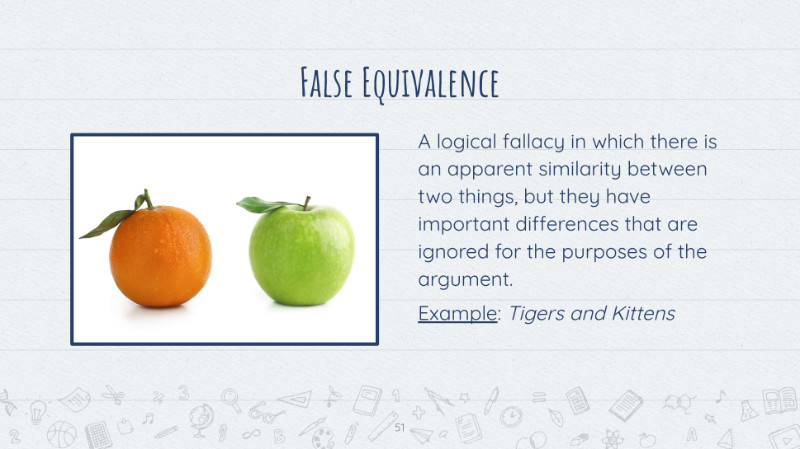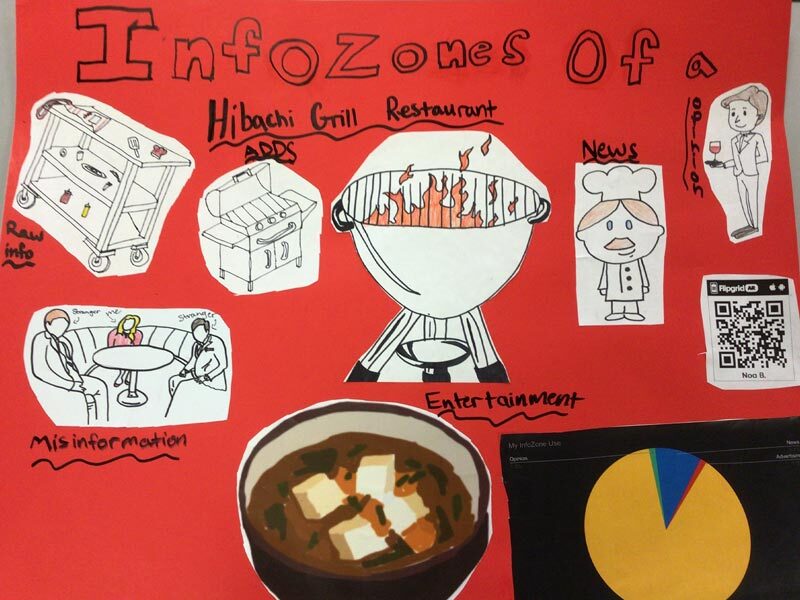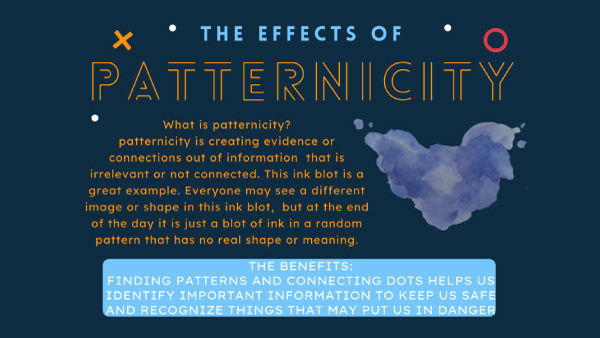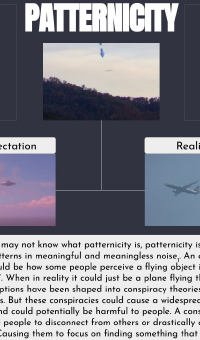Empowering future engineers: An educator’s innovative approach to news literacy
When educator Kelly Melendez Loaiza recently saw an image of a trash-filled catch basin online, she looked past the wet garbage in a hurricane-flooded road and spotted the intersection of news literacy, science and current events.
Melendez Loaiza, who has been teaching for 18 years, joined Davies Career & Technical High School in Lincoln, Rhode Island, this fall to lead its new environmental engineering program, part of the school’s pre-engineering career path. But she has been weaving news literacy into her classes since 2016, when she developed a Science and the Media course at a Massachusetts high school.

Harold Hanka for the News Literacy Project
“If we’re paying attention, we can pull current events in and make media literacy relevant for students,” said Melendez Loaiza, who builds her curriculum around NLP’s Checkology® virtual classroom. “Those lessons are incredible. I couldn’t teach this without Checkology.”
For example, on a recent afternoon, a class of sophomores explored logical fallacies using Checkology’s “Arguments and Evidence” lesson in the context of the pros and cons of nuclear energy, the topic they are currently studying.
Why news literacy matters
Environmental engineers need to be news-literate, Melendez Loaiza believes, because they design systems to protect air, water and the land at the societal level and must interact with community leaders and the public about their work. “They need good communication skills to understand the problems they are trying to solve and the values of the communities they are working with to design solutions that meet the needs of the people being served.”
The catch basin example provided what at first glance looks like a simple issue of trash in a street. But it provides an opportunity for students to use news literacy skills to explore a topic from several perspectives, identifying multiple pathways for solving complex problems. “I bring media literacy back to the science,” she said. “It’s needed to open our minds to all the angles of the problem.”
When her students begin thinking in media literacy terms, the parallels with how they ponder science and engineering emerge and complement one another. Ultimately, it improves their overall critical thinking skills, she said.

Harold Hanka for the News Literacy Project
Students want news literacy education
Melendez Loaiza found that when students begin to practice news literacy, they wonder why they hadn’t been taught it earlier. This sentiment jibes with a key finding from NLP’s newly published study, News Literacy in America: A survey of teen information attitudes, habits & skills (2024): 94% of teens say that schools should be required to teach media literacy. “This should be a basic skill,” student Xavier Dias noted.
Students have also said that learning news literacy skills changed how they engage with others on topics when they disagree. They’ve learned to listen and see arguments from multiple perspectives. “They felt ready to engage in civil discourse because what they had learned quite literally changed them,” Melendez Loaiza said.
Not all information is equal
Melendez Loaiza began her news literacy instruction at Davies High School with the Checkology lesson “InfoZones.” It describes the primary purposes of different types of content, teaching students that all information is not equal. “There can be more to the story than how it’s portrayed,” observed student Jacob Xajap.

Harold Hanka for the News Literacy Project
His classmates also demonstrate understanding of other news literacy key concepts. “When I’m scrolling the news, it’s important to me if there are multiple sources to see if it’s true,” said Aidan Baptista, who recognizes the broader impact of what he is learning. “I feel like it will help me to be more open minded when approaching news and other information.”
‘It can change people’
Melendez Loaiza also teaches Checkology’s “Conspiratorial Thinking” lesson exploring the psychology behind beliefs in this form of misinformation, which teens often encounter. In fact, NLP’s recent survey found that 80% of teens on social media say they see posts that spread or promote conspiracy theories, and of those, 81% say they are inclined to believe one or more.
Student Maddy Lefebvre said that when she encounters likely conspiracy theories, she now has the awareness not to be fooled. “I’ll personally look into it more before believing it.” Classmate Joshua Malmberg agreed. “There’s always something that doesn’t make sense.”
Melendez Loaiza is confident that teaching these future environmental engineers to become more news-literate will help them outside the classroom. It will make them better able to understand current events, be curious but not cynical and communicate with empathy, all of which will be required in their professional lives.
“Every little piece they learn about media literacy is another piece of the puzzle in understanding the world,” she said. “When people are exposed to this in a supportive environment, it can change people and change the world, I believe, for the better.”
Checkology wins prestigious Webby Award
NLP’s digital learning platform Checkology® has won a prestigious Webby People’s Voice Award, the International Academy of Digital Arts and Sciences announced today.
The Academy’s 28th annual awards honor the “best of the internet,” recognizing artists, media companies and other creatives at the leading edge of tech and culture. Checkology won in the category of Websites and Mobile Sites — Responsible Information, which recognizes products, platforms, software and other technologies working to combat disinformation, misinformation and false or misleading information online.
Checkology was selected as an honoree from among 13,000 entries across the world. The Academy noted that just 4% of those entries won a Webby Award. The People’s Voice Award is decided by a popular online vote. The academy said more than 550,000 people cast 2.2 million votes this year.
“The future of our shared civic life depends on young people learning the skills necessary to find credible information online,” said News Literacy Project President and CEO Charles Salter. “Checkology is the most comprehensive resource on the internet to do just that. We are honored by this recognition and remain committed to our mission of building a future founded on facts.”
Checkology teaches vital news literacy skills
Checkology, a free digital learning platform, teaches people how to identify credible sources and discern fact-based information in a sea of falsehoods, manipulated content and viral rumors. The platform features 19 foundational news literacy lessons on topics including misinformation, conspiratorial thinking and news media bias. Respected journalists and leading experts guide the interactive lessons, which include real-life examples drawn from the internet, including social media platforms such as TikTok.
Primarily intended for middle and high school, more than 100,000 students used the platform last school year. Independent evaluations show students who completed Checkology lessons learned vital skills, including how to identify when social media posts fail to provide credible evidence. Launched in 2016, Checkology is just one of the many free resources offered by the News Literacy Project and used by educators in all 50 states.
Winners will be honored at a gala hosted by comedian Amber Ruffin on Monday, May 13, in New York City.
School’s entire freshmen class learning news literacy with NLP’s resources
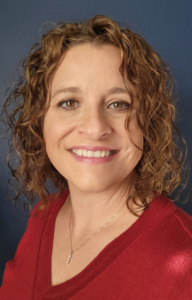
Photo courtesy of Pam Szabo
If educator Pam Szabo were a student today, she’d probably be the kid asking the teacher for extra homework.
“I like to be busy. That’s who I am,” said Szabo, a veteran English teacher and reading specialist who joined La Salle College High School in Wyndmoor, Pennsylvania, a Philadelphia suburb, as a part-time library assistant in fall 2022, when her son enrolled as a freshman.
La Salle, a Catholic all-boys college-prep school, transformed its traditional library into the McShain Center for Digital Research and Collaboration, and Szabo envisioned all the ways she could make an impact. “With my ambitious personality, I began to ask for more and more responsibilities. I was bugging my dean, ‘What else can I do, what else can I do?’”
So, the dean asked her to create a media and news literacy curriculum as a component of the school’s required freshman course, Introduction to Technology and Design.
“I have a great interest in curriculum design and development, so I started to dig for resources to teach this,” she said.
Szabo came across the News Literacy Project’s Framework for Teaching News Literacy and then discovered Checkology®, NLP’s e-learning platform. She likes that subject matter experts guide students through the lessons and that the topical subjects and examples from social media make the material relevant.
An investigative news literacy curriculum
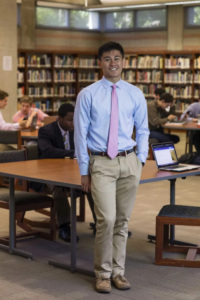
Photo courtesy of La Salle College High School
To develop the curriculum, she watched all 19 Checkology lessons and found that this exercise also benefited her as a media and news consumer. “It made me stop and think of what I see in media. It made me more aware,” said Szabo, who is now the school’s media literacy instructor. Using NLP resources, she teaches more than 300 freshmen each year.
She focuses her sessions around nine Checkology lessons, including “Arguments and Evidence,” “Evaluating Sources Online” and “Introduction to Algorithms.” She frequently uses challenges offered within the platform’s Check Center, where students put their investigative skills to the test.
Szabo works through the lessons and exercises with her students, stopping frequently for discussion and closer examination. For example, she might present an image from the Israel-Hamas war and stop to ask questions that test the students’ critical observation skills: “What do you think you’re looking at? Who is saying what? Do they have the authority to say it? Is there money involved?”
Students enjoy the investigative nature of the class and are often surprised that an authentic-looking social media post is doctored, fabricated or taken out of context by a source that lacks credibility, she said.
Concepts apply to many disciplines
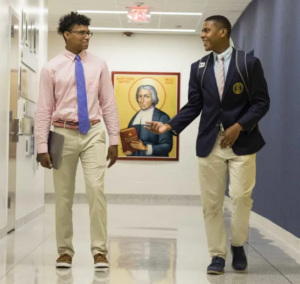
Photo courtesy of La Salle College High School
At her dean’s request, Szabo is preparing to give a presentation to colleagues explaining what it means to be news-literate and demonstrating how other teachers can incorporate news literacy skills into their lessons. She also will promote the value of having a journalist as a guest speaker in class because it provides real-life authenticity and could relate to a variety of disciplines, she said.
Szabo already has witnessed how students apply their new skills in other settings. “I was helping with a research project in social studies classes, and I heard them using terminology from Checkology about finding credible resources and using some of the skills they learned — especially lateral reading.”
She noted that educators don’t need to dedicate a full class period to teach this important material. “It’s very doable even if you don’t have a lot of time. You can do it as a bellringer. And it’s valuable for assignment modules when you have a substitute teacher.”
Vote for us! Checkology is nominated for a Webby Award
Move over “Oppenheimer,” the News Literacy Project’s Checkology® digital learning platform is in the running for top honors in The Webby Awards, the Academy of Digital Arts and Sciences’ signature awards program.
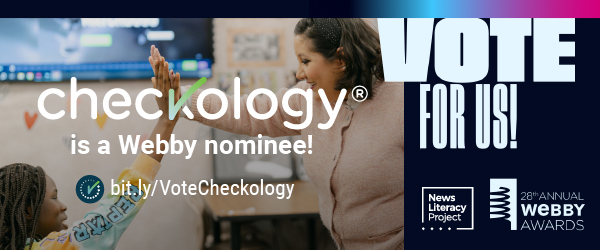
Checkology, our field-defining news literacy product, is one of five finalists in the websites and mobile sites category Responsible Information. Just being nominated is a big win. Our entry was one of 13,000 projects from around the world vying for honors in this category.
Even better, NLP has two chances to come out on top: The Webby Award, which is chosen by the Academy itself, and The Webby People’s Voice Award, which the public chooses. “Both awards are a mark of international distinction for Internet excellence,” the academy’s president Claire Graves wrote in when notifying us that Checkology was a finalist.
Here’s where you come in. The public voting period has begun and is open until Thursday, April 18, at 11:59 PDT. Please visit the Webby site to cast your vote for Checkology today. It’s quick and easy.
The academy will announce the winners on Tuesday, April 23, and will celebrate the honorees at the 28th Annual Webby Awards gala hosted by Amber Ruffin on Monday, May 13 in New York City.
Thank you for supporting NLP and a future founded on facts.
Science teacher couldn’t have planned it any better
His course was ready to meet new media literacy requirement
Illinois high school educator Tom Foss credits his experience with both skeptics and conspiracy theorists and a background in science and humanities for preparing him to teach media literacy.
“I used to be active in scientific skepticism circles. I did presentations on chain letters, scams and conspiracy theories. That was my window in, and I think a lot of critical thinking is just scientific thinking,” said Foss, who teaches chemistry, physical science and physics to grades 9-12 at Newark Community High School in rural Illinois.
Having majored in physics and English in college, he brings these dual perspectives to the classroom. Nearly a decade ago, he began assigning research projects to his chemistry students and included a lesson on how to find reliable scientific sources. Then the pandemic hit, suspending in-person classes. “I needed something to teach on our remote days,” Foss said.
He found the Stanford History Education Group’s Civic Online Reasoning resources and other material for teaching students how to determine the credibility of sources and information. By the end of the 2020-21 school year, he had built a curriculum that brought a science lens to media and news literacy, but he had no place to fit it into his courses.
“I saw much more retention and deeper thinking and more tangible results by doing this as an extended process. This made it really clear we needed more than one unit,” he said.
Mandating media literacy
Foss spoke with teachers who recognized the value of his approach and then learned that Illinois was about to pass a law requiring media literacy instruction beginning in the 2022-23 school year. Foss called it serendipity, but at his school his work was more like the catalyst for a news literacy chemical reaction — a process that generates products which then sustain that process.
With a curriculum in hand, media literacy became a semester-long required class for freshmen at his school in fall 2022. When researching resources for the new class, Foss discovered the News Literacy Project and its Checkology® virtual classroom, which helped him bring a comprehensive approach and common vocabulary to the course. Among the Checkology lessons he teaches are “InfoZones,” “Misinformation,” Understanding Bias” and “Making Sense of Data.”
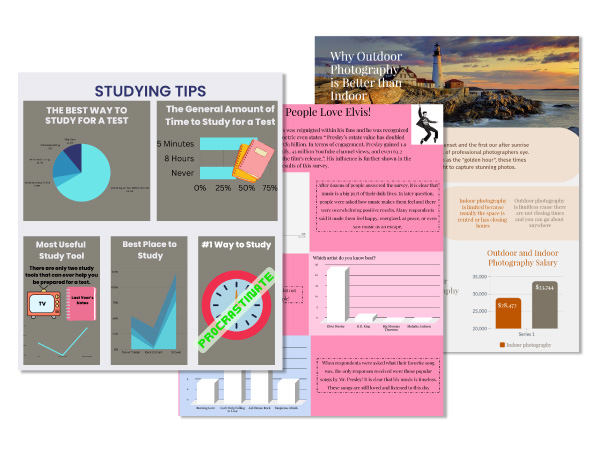
Work done by students in Foss’ class.
Foss wants his students to understand that things often are more complicated than they seem, with a greater level of complexity underneath. “The simple narratives are almost always obfuscation. You should always question simple things that feel right,” he tells his students. He wants them to have the skills to analyze information, find credible sources and be open to changing their minds when confronted with evidence that contradicts their beliefs. “That’s a really hard thing for anyone to do.”
The course has opened students’ eyes to the darker elements of the internet. They are surprised to discover how easily their privacy can be violated, how little control they ultimately have over what they post and how seamlessly legitimate content can be turned into misinformation.
“They’ll notice a deepfake edit but they’ll miss the caption that gives it false context. I tell them the easiest way to fool you doesn’t require Photoshop or After Effects, it can take only a few words,” he said. “I’m really proud when I start seeing the kids make distinctions between what they’re being told and what they’re seeing.”
Artificial intelligence a new challenge
This skill is particularly important given the ways artificial intelligence is making it increasingly difficult to tell what’s real and what’s not. And that goes for educators, too, as students have always found hidden ways to get others to help with assignments. Up to now such interference has been decidedly analog. “It’s more that kids have their friends do their homework. The original AI.” Foss quipped.
Before the 2022-23 school year even ended, he was thinking about ways to improve his curriculum for the fall. He’ll create a “bell ringer” activity to start each class; he’ll tweak the lesson sequence; pare down some sections and beef up others, and give students a more active role. “I want them to do more hands-on work rather than listening to me talk,” he said.
And Foss can’t wait to see what lasting impacts media and news literacy competency has on his students. “I’m really interested to see this group of freshmen four years from now when they do their senior capstone [research] projects.”
Tapping into kids’ creativity to teach news literacy
Educator Mary Ellen Wessels realized that she has been teaching media and news literacy across grade levels and disciplines for some time. She just never called it that.
“Honestly, it’s only fairly recently that I’ve been aware that I’m teaching media literacy, but in reflection, even when I taught 4-year-olds, I tried to include media literacy,” said Wessels, a humanities and civics teacher for grades six through eight at Gate City Charter School for the Arts in Merrimack, New Hampshire, a nonprofit public charter school.
When teaching preschoolers, she would introduce basic concepts in conversations largely built around visuals. For example, her class compared differences between toy ads “for boys” and those “for girls” or looked at how TV depicted people or events compared to real life.
With middle school students, Wessels builds on their understanding of concepts from one grade to the next. Sixth graders focus on becoming more aware of how media is used, asking questions around who is telling the story and why. Seventh-graders explore how primary sources might provide two different versions of the same story. By eighth grade, her classes are studying propaganda in a historical context.
Students as media savvy creators
“I’m always trying to get students to think of themselves as creators, so I’m trying to make media literacy one of their civic duties. You need to use your media savvy,” Wessels said. “When it comes to social media, I want my students to think critically and use it for positive things.”
And, she believes news literacy can and should be taught across disciplines.
She recently wove news literacy into her eighth grade ELA classes using NLP’s Checkology® virtual classroom lesson “Power in Art: The Watchdog Role of Editorial Cartoonists.” It focuses on the history and current role of this important form of opinion journalism. Students created their own editorial cartoons based either on a line from the book Animal Farm by George Orwell or a current topic they cared about.
Visit from editorial cartoonist
Wessels then invited Signe Wilkinson, a longtime editorial cartoonist at the Philadelphia Daily News who is featured in the lesson, to a virtual classroom visit.
She has been visiting classrooms in person, and since the pandemic, virtually, for years and truly enjoys it. “Right before the pandemic, I went to a middle school in Malvern (Pennsylvania) and spoke to four or five classes in a row about cartooning generally,” said Wilkinson, the first woman to win the Pulitzer Prize for editorial cartooning. “It was fascinating because they don’t get newspapers, so they don’t see cartoons in the way I see cartoons.”
Her classroom conversations start with a quick history of communication through visual imagery, beginning with the first cave paintings and moving on to Martin Luther, the 16th century German theologian and Protestant reformist who used illustrated engravings to reach people who couldn’t read. She also discusses the work of 19th century American cartoonist Thomas Nast and political cartoons from World War II, before sharing her own drawings.
“I don’t want it to be all about me,” says Wilkinson, whose work can be seen in The Philadelphia Inquirer.
An empowering connection
Wessels said Wilkinson was engaging, and her students made the connection between using visual art and written language to persuade people and make them think. “Many of our students are naturally visual thinkers and artists. And a lot of them identified with how she struggled to pay attention in class but always wanted to draw.”
Wilkinson told the class of the challenges she faced in establishing her career, noting that she was one of only a few women political cartoonists when she began, and the field remains male dominated. Some students were surprised by the idea of creating cartoons as a career or the possibility that they could be an activist and use their voice and art at the same time.
“It is so empowering to have students get encouragement from professionals in the field,” Wessels said.
Wilkinson boiled down her message to this: “The main thing is to let kids realize that you don’t have to just write news stories about what happens. You can use visual imagery for all sorts of things when you want to reach people in different ways, because people learn in all different ways.”
Educators: To arrange for Wilkinson to visit your classroom, contact her at [email protected].
New Checkology® lesson explores history of racism in mainstream news
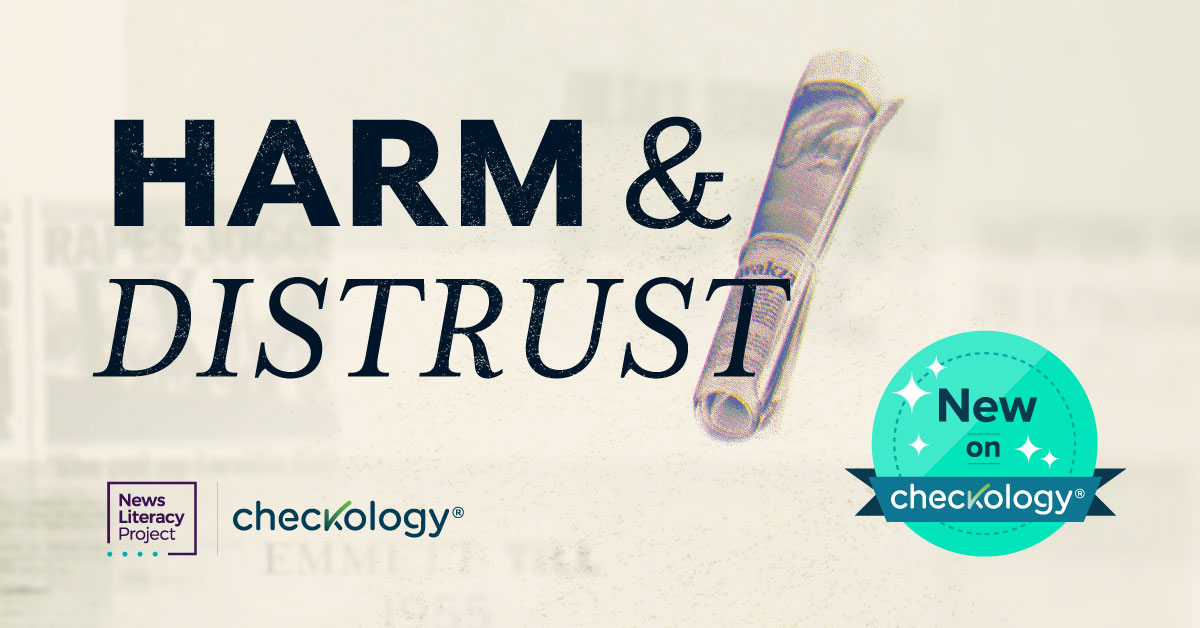
Newsrooms across the country aspire to standards and guidelines designed to minimize the influence of individual biases and to produce journalism that is fair, accurate and in the public’s interest. But for all the positive and crucial roles the press plays in American democracy, institutional news organizations also have legacies of exclusion and blatant harm that have severely eroded trust among specific groups of people.
The News Literacy Project tackles this complex but essential topic in its new interactive lesson, “Harm & Distrust,” available now for educators and students. The six-part module explores the history of racist mainstream news coverage of Black Americans as a case history to draw the larger subject of historic harm into focus. It’s hosted by veteran journalist Natalie Moore, who covers segregation and inequality for WBEZ Chicago.
The lesson begins by outlining four aspects of standards-based news coverage that, by necessity, require subjective judgments and hence more of the public’s trust: story selection, framing, tone and sourcing. Students then apply their understanding of these four concepts to a survey of historical coverage across three historical periods, exploring examples of openly racist news coverage from the Jim Crow era, the Civil Rights era and the late 20th century.
The lesson also covers the role that the Black press played in providing more accurate, urgent and critical coverage of atrocities — such as the murder of Emmett Till in 1955 — in sharp contrast to coverage by mainstream news organizations at the time.
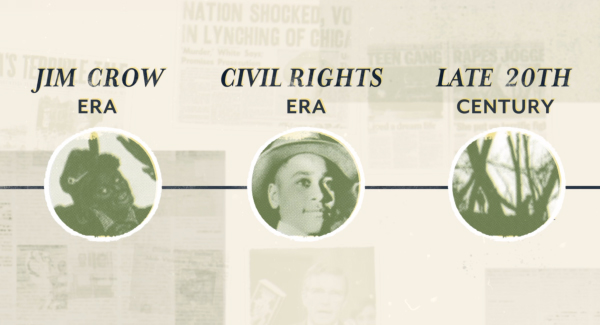
Students also explore the findings of the 1968 Kerner Commission Report, which issued a searing indictment of the American news media’s failure to accurately represent the lived realities of Black Americans. The report’s recommendations for the media at the time bear a striking resemblance to the findings of a 2020 study by the Center for Media Engagement, which surveyed 1,000 Black Americans about mainstream news reporting on Black communities.
These documents — published more than 50 years apart — underscore the need for news organizations to increase racial diversity in newsrooms, to include Black Americans in coverage of ordinary life, and to develop relationships and sources in Black communities. In the lesson, students are asked to match similar recommendations from the Kerner Commission Report and the Center for Media Engagement’s study, underscoring the persistence of these long-standing needs.
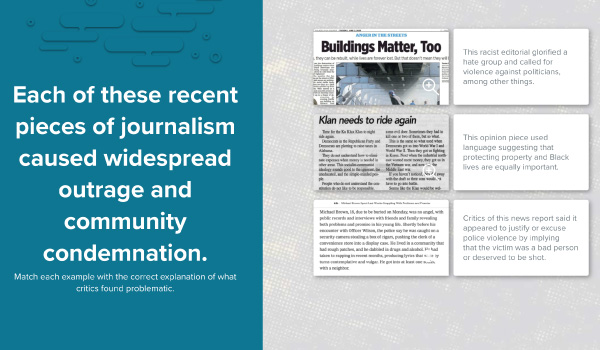
Even as it draws attention to these continuing challenges, “Harm & Distrust” clearly acknowledges the demonstrable progress that has been made in newsrooms across the country.
The final section of the lesson looks at steps some news organizations have taken to increase newsroom diversity, including at the leadership level, and to be more accountable to the communities they serve. It explores four examples of news organizations working to take responsibility for racist historical coverage through published audits and apologies. These include the Orlando Sentinel’s audit and apology published in 2019; the Los Angeles Times’ examination of its “failures on race” published in 2020; The Kansas City Star’s 2020 apology for its history of racist coverage; and The Baltimore Sun’s sweeping apology for a multitude of past wrongs published in 2022.
Moore concludes the lesson by acknowledging that this subject is both painful and difficult, but it’s also necessary to confront if we hope to make journalism better.
“I still believe in the power of journalism to be the voice of the voiceless – to expose injustice, including racism – and bring about positive change that improves people’s lives. If I didn’t, I wouldn’t have dedicated my career to doing this work.”
“Harm & Distrust” concludes with a challenge for students: to help hold news organizations accountable to their own ideals and to the practice of improving coverage in ways that ensure they serve all members of the public equally.
You can preview this important new lesson and find the learning objectives and essential questions for discussion on the “Harm & Distrust” preview page. To assign the lesson, sign in to Checkology or register for an educator account. (As a reminder, Checkology is completely free!)
Checkology lessons and associated resources were created with the generous support of our funders.
Understanding ancient history using modern news literacy skills
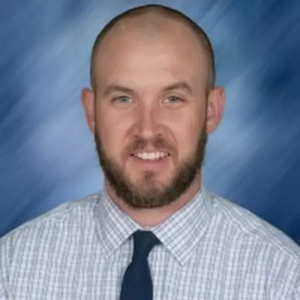 Middle school teacher Chris Bily’s media literacy course is designed to give students the skills to become more news-literate, but it actually does much more. It bridges millennia and enhances his seventh-grade ancient history classes.
Middle school teacher Chris Bily’s media literacy course is designed to give students the skills to become more news-literate, but it actually does much more. It bridges millennia and enhances his seventh-grade ancient history classes.
“It’s the obvious connection between critical thinking and historical thinking skills,” said Bily, a social studies teacher at Whitnall Middle School in Milwaukee County, Wisconsin.
The media literacy course he created, offered as part of the school’s six-week sessions of “mini-courses,” reaches nearly 180 students, or about 90% of the seventh grade. He sees students apply what they learn to the research they undertake in his social studies classes: “How do I know where this information is coming from? How do I know what the bias is? Who is the person providing the information?”
For his media literacy curriculum, Bily uses lessons and accompanying challenges and exercises from NLP’s Checkology® e-learning platform, as well as other resources. They include The Daily Juice newsletter for students, from the education platform The Juice, a partner of NLP.
Current media examples matter
An educator with a dozen years of experience, Bily has been teaching media literacy education for several years and has used Checkology since its launch in 2016. His students like the interactive nature of the lessons, such as “Practicing Quality Journalism,” which lets students play the role of a reporter in a simulation of a breaking news scene.
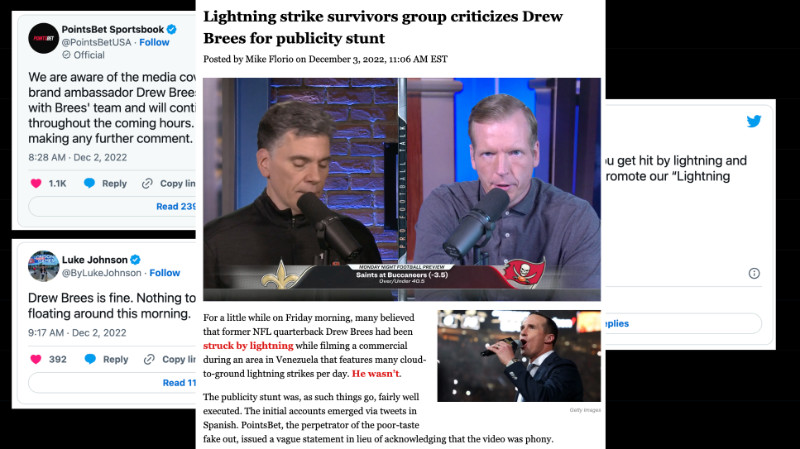
Bily also appreciates the ability to customize Checkology using the independent learner version of the lessons rather than the teacher-led option. “I’ve got all sorts of readers, all sorts of student needs. it’s more conducive to diverse learners.”
And the timeliness of lesson examples, taken from real news events, grabs his students’ interest more than a textbook might. “It’s the difference between trying to sell kids on people from 2,000 years ago who are dead than something they’re seeing now on YouTube,” he said.
Social media platforms’ use of algorithms — machine learning that surfaces specific content based on a person’s online habits — is a topic that also engages his students. On a recent school day, the topic came up in his social studies class. He told his students he typed the word “Jaguars” into a search engine, and based on his online habits, the results included the NFL team the Jacksonville Jaguars, rather than the luxury car or the big cat.
“Kids relate to that. They were talking about how what you look up changes what you’ll see in your results,” Bily said.
Making the First Amendment relevant
Similarly, he can pique students’ interest in the First Amendment, which is essential to becoming more news-literate, when he makes it relevant to their daily lives. “That’s a tough sell unless you make it about them: Can you say this in school? Can you wear that in school?”
And the 2022 Annenberg Public Policy Center survey, in which 25% of respondents could not name one of the five freedoms protected under the First Amendment, offered a chance for his students to flaunt their knowledge. “They think it’s awesome when they know more than the adults do,” he said.
Recognizing the value of Bily’s course, his district’s Teachers Leading Teachers team has asked him to put together a professional learning segment about Checkology for his colleagues. He’ll likely share that at the start of his media literacy course, he administers Checkology’s pre-assessments, which give him — and his students — insight into their familiarity with the topics. “I want them to know what they don’t know. Sometimes they get frustrated and say, ‘I don’t know what this is.’”
But by the end of the course, they know.
New STEM-Aligned Lessons Released on Checkology®
Educators asked, and we’ve answered! In response to requests for STEM-aligned lessons on Checkology®️, the News Literacy Project’s free, browser-based virtual classroom, we’ve added a trio of new lessons: “Evaluating Science-Based Claims,” “Be Health Informed” and “Making Sense of Data.”
These lessons support students’ understanding of science and math principles, such as evaluating methods and evidence. They also incorporate real-world issues such as climate change, the COVID-19 pandemic, vaccines, medical and scientific misinformation, pseudoscience and conspiratorial thinking.
Educators in the sciences, mathematics and social studies will find these new lessons particularly useful for drawing connections to current events and information students encounter online. The lessons also make valuable additions to subjects such as journalism and history, providing or enhancing foundational understandings of science and data literacy.
Learn more about each of the lessons below.
“Evaluating Science-Based Claims” boosts students’ science literacy

Scientific findings have shaped our entire world, from our methods of transportation to how we communicate with one another. Most people don’t question the science behind everyday conveniences such as cars and cell phones, but topics such as climate change – which can disrupt our worldview and previous beliefs – can lead some to question the validity of science, regardless of the evidence and scientific consensus. In addition, some people use pseudoscience to support beliefs that have no scientific accuracy.
“Evaluating Science-Based Claims” teaches students how to evaluate science-based claims using an easy acronym, FLOATER (Falsifiability, Logic, Objectivity, Alternative explanations, Tentative conclusions, Evidence and Replicability), developed by the lesson’s host, Melanie Trecek-King. Trecek-King is a scientist and a teacher at Massasoit Community College in Brockton, Massachusetts. She advocates for science literacy on her website, thinkingispower.com.
- Try out a preview of the lesson.
“Be Health Informed” empowers students to evaluate health and wellness information
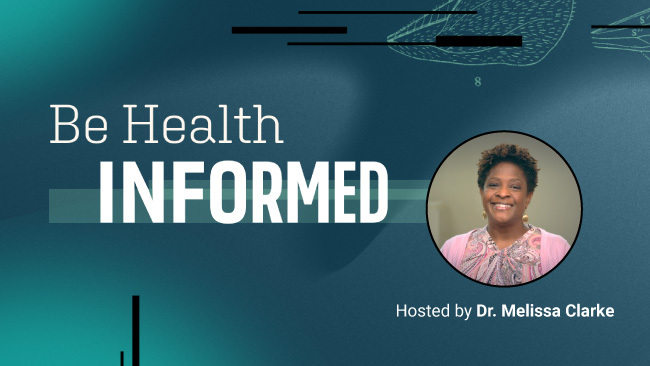
We make decisions about our health and well-being all the time – from how much we sleep to which treatments we seek out when we get sick. The stakes couldn’t be higher where our health is concerned. The new Checkology lesson “Be Health Informed” teaches students how to spot health misinformation and discern which sources are credible and based on quality evidence, so they can avoid being misled.
Students learn to watch out for red flags when encountering misinformation. They also get a glimpse into why certain groups are vulnerable to health misinformation.
“Be Health Informed” is hosted by Dr. Melissa Clarke, the former assistant dean of the Howard University College of Medicine and CEO of the Be Health Empowered Group.
- Watch a 1-minute video segment from the lesson.
“Making Sense of Data” teaches students to be data savvy
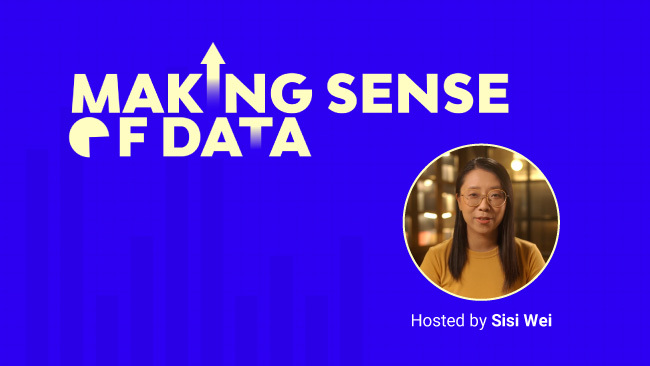
Data is all around us, whether we know it or not. When we pick up our phones, “like” something on social media or do a simple internet search, we are generating and being influenced by data.
In “Making Sense of Data,” students learn how to better understand and analyze the accuracy and credibility of data. Students discover how credible data is produced, why no data is objective or infallible, and what makes some data more valid than others. They also learn to recognize and avoid common pitfalls in how data is interpreted and visualized.
The lesson is hosted by Sisi Wei, a data journalist and the editor-in-chief of the nonprofit newsroom The Markup. Previously, she was the co-executive founder of OpenNews.
- Watch a 1-minute video segment from the lesson.
NLP’s new STEM-aligned lessons on Checkology were created with the generous support of our funders. Additional funding was provided by The Science Literacy Foundation and Smart Family Fund.
Free educator event!
Explore all three new lessons in an educator webinar, “STEM-aligned media and news literacy lessons for your classroom,” on Wednesday, Sept. 28 at 7 p.m. ET/4 p.m. PT. Melanie Trecek-King (host of “Evaluating Science-Based Claims”) and News Literacy Project staff will introduce the lessons and share how you can use them with your students. Register now.
Hometown Headlines contest winner covers pandemic from student perspective
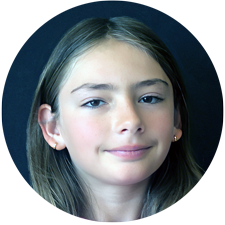 For Los Angeles middle school student Willa Earnest-Blum, the jarring re-entry into the social landscape of in-person classes after pandemic restrictions ended inspired an idea that led to a news story.
For Los Angeles middle school student Willa Earnest-Blum, the jarring re-entry into the social landscape of in-person classes after pandemic restrictions ended inspired an idea that led to a news story.
A student at Girls Academic Leadership Academy in Los Angeles, Willa pitched her story idea about the difficult adjustment to the News Literacy Project’s first Hometown Headlines contest. To enter, students submitted a news story idea to NLP staff, who chose the best pitch to develop into an article.
Willa’s journalism teacher Jessica Valera encouraged her to enter the contest after she finished her Checkology® virtual classroom lessons ahead of schedule.
Her experiences at her school gave her the idea for the story, as she and her classmates were finding ordinary in-person interactions awkward. “It just came to mind,” she said. “I feel like it’s really evident right now at my school. My experiences day to day made me think of it.”
Yet, she and her friends didn’t talk about the issue, which made her recognize the need to tell the story. “It made it more important to me.”
She wrote:
Teachers and students started questioning how a return to normal, in-person classroom settings — where one is seen constantly — has impacted those who for so long adapted to logging onto class from the comfort of home.
Students were once behind a screen, free of other people’s eyes. Now every little mistake was amplified by being front and center.
Her mom, Rebecca Baron, said she didn’t even know Willa had entered the contest until Valera called to say she had won. “She really did it on her own. She was very independent in doing this, and I am really excited for her.”
Importance of multiple perspectives
Willa, 12, interviewed her teacher, a classmate and the school counselor. “I felt like it was important to cover all the bases of different perspectives. It taught me a lot talking to my counselor and my teacher and my classmate because I got to see their perspectives, which was sometimes different from mine.”
With the help of NLP staff — Katie Aberbach, education marketing manager, and Kim Bowman, senior associate of user success — Willa created a Google Doc to organize her reporting, complete with checklists, names of sources and the information they provided. Aberbach then helped connect Willa with local reporter Brandon Pho, a journalist at Voice of OC in California and a Report for America fellow. He helped Willa develop the story during a series of virtual meetings.
Her thoroughness immediately impressed Pho. “She organized her reporting better than I organize my notes out in the field,” Pho said. “We would go to that document and ask, ‘What is this story about? What are the voices? What do they have to say?’”
He asked her what stood out to her as the most interesting piece of information in her notes, and this sparked Willa’s idea for story’s opening:
Nearly 700 kids at Girls Academic Leadership Academy (GALA) are a window into an issue affecting nearly 50 million public school students nationwide.
“That lede was entirely her idea,” Pho said, referring to the opening paragraph of a news story intended to entice the reader.
Connecting with the reader
Willa said Pho helped her find the heart of her story. “He really taught me how to take a small quote and something I thought would not be important and to give it a longer, deeper perspective.”
In working with him, Willa began to better understood her own feelings about the issue and was able to translate this into something the reader could connect to. And sometimes, she learned, this means leaving things out. “We talked about things that could take away from the overall message. You don’t need to say it all,” she noted.
Pho said he found the experience rewarding and gained insights into his work as he considered the basic concepts of journalism and shared them with Willa. In the end, he thought Willa’s article was a strong piece of journalism.
“As long as she has a story to tell, it doesn’t matter that she was a sixth grader. It wasn’t a good news story, it was a great news story,” he said.
The Voice of OC wrote about Brandon’s role as a mentor to Willa and published her piece.
Educator instills appreciation for journalists who confront press freedom limits
For Kristin Larson’s journalism students, studying press freedom is more than an academic exercise. She acquaints them with journalists who have put themselves at risk to reveal important information that people in power would prefer to remain hidden.
Larson, an English teacher at South Windsor High School in South Windsor, Connecticut, uses NLP’s Checkology® virtual classroom lesson “Press Freedoms Around the World” as a foundation.
They also watch Palestinian photojournalist Eman Mohammed’s TED Talk, “The courage to tell a hidden story,” and analyze one of her images: a photograph of Palestinian photographer Faiz Moemen, who lost his legs during an airstrike. He sits in a chair holding a camera, while a wheelchair with a camera on the seat is next to him.
Exploring press freedom limits
With this unflinching introduction, Larson’s class of ninth to 12th graders begins to understand the courage needed to tell the truth when others might not want it to be told and the impact of such work.
“I want them to learn the risks of finding the hidden story and the risks of telling it,” Larson said.
Her students then choose a leading international journalist as their focus for a class presentation. They research the person’s education, experience and important work, and compile quotes and video clips.
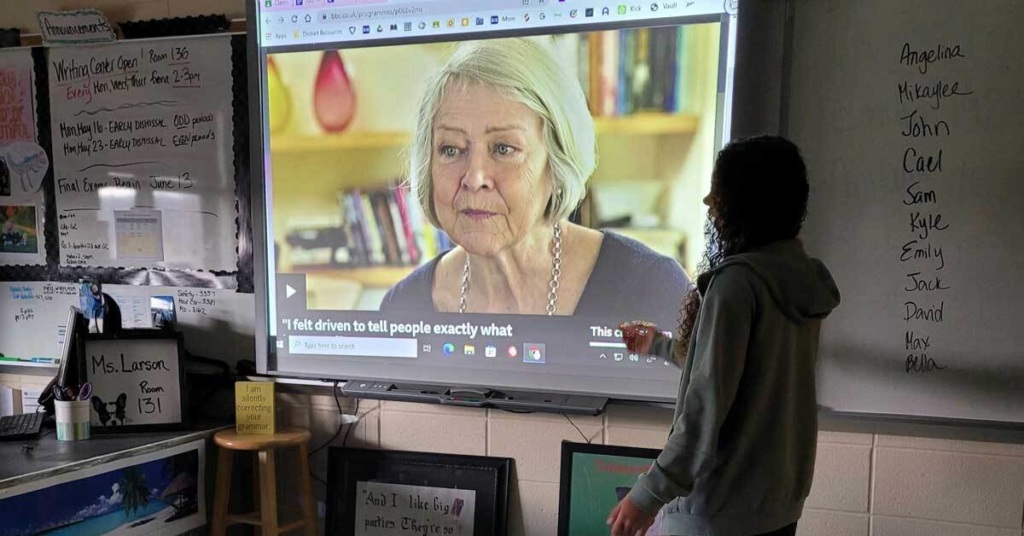
A student in Kristin Larson’s journalism class gives a presentation about British journalist Katie Adie. The South Windsor, Connecticut, students were studying world press freedom. Photo by Kristin Larson
Larson ranks the presentations based on the degree of press freedoms in that journalist’s country, starting with the greatest freedoms and ending with the least. She bases her determinations on the Reporters Without Borders (RSF) annual World Press Freedom Index, which the students learn about in the Checkology lesson.
Last week’s presentations included journalists from Ireland and the United Kingdom, with greater freedoms, and Sudan, Saudi Arabia, China, North Korea, Venezuela and Russia, with lesser freedoms. The timing of the assignment is ideal. World Press Freedom Day is May 3.
Students use a section of the Checkology press freedoms lesson that describes the basis for a nation’s press rankings — whether journalists and news outlets have legal protections, who owns media companies, etc. They then answer questions based on what they learned from one another’s research.
And as a warmup, Larson asks her class where they think the United States ranks. “They all picked the U.S. as first in the rankings. They were really surprised” to learn it ranks in 44th place in the 2021 index.
Practicing journalists
By the end of the semester, her students gain life skills like critical thinking and a better understanding of how the world works and their place is in it. But they also practice those skills from the start.
Soon after class begins, they write for the school’s news site, The Bobcat Prowl (Larson is the adviser), or collaborate with the broadcast news class to develop a story for the school’s news channel, Bobcat News. The students also write for the yearbook. And she trains a few students as editors who help prepare their classmates’ work for publication.
Larson likes teaching this elective course because her students can pursue stories that interest them and have the room needed to reflect on what they learn. “They feel hope in our future because they know there are journalists searching to give the unbiased truth. It teaches them to read with an open mind, to spot bias,” she said.
And what they decide to cover is entirely up to them. “They can write whatever they want,” she said.
That means students sometimes turn their attention to events and issues beyond school grounds. For example, student Samantha Deras recently wrote about the role of women in Ukraine.
Larson began teaching journalism during the first months of the pandemic and discovered Checkology in late 2020, when she and the school’s library media specialist attended a virtual NewsLitCamp® — one of NLP’s professional learning events. “It was so good. They showed us Checkology, and since then we’ve been using it,” she said. “We were very inspired.”
Through her impactful, hands-on approach to teaching journalism, she’s inspired her students to understand press freedom on a deeper level as well.
NLP introduces “Power in Art,” a new lesson on editorial cartooning
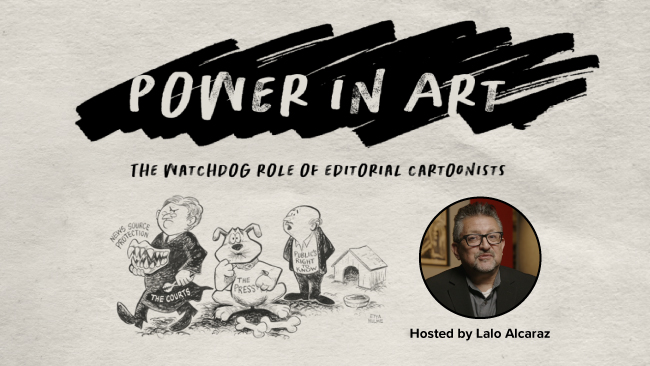
Editorial cartoonists are known for their masterful, often trenchant use of images and text to express opinions or provide critique. Sometimes their work even propels national conversation or social change.
Now, students have a chance to explore the formidable history and impact of editorial cartoonists through a new, comprehensive Checkology® lesson, “Power in Art: The Watchdog Role of Editorial Cartoonists.” The lesson is included with the News Literacy Project’s free Checkology virtual classroom and is currently available to all educators. (You can preview the lesson here. To assign this to students, log in to or register for Checkology.)
“Editorial cartooning is a fascinating, complex form of opinion journalism, and we are very excited to incorporate this lesson into Checkology,” said Peter Adams, NLP’s senior vice president of education. “Guided by our subject matter expert, the award-winning editorial cartoonist Lalo Alcaraz, students trace the role of editorial cartooning through history and gain valuable skills for analyzing and interpreting these powerful drawings, as well as other modern forms of graphic expression. With its international, multidisciplinary scope, this lesson would make a great addition to many course curricula, including social studies, history, journalism, media studies and art.”
The lesson provides an in-depth look at how the work of editorial cartoonists has held those in power accountable, as well as the characteristics and challenges of this important form of opinion journalism. Students analyze cartoons from around the world, with iconic examples from Benjamin Franklin, Charles Philipon, José Guadalupe Posada and others. The lesson also invites students to compare editorial cartoons with modern forms of graphic political expression, including memes.
Alcaraz, whose work has appeared in newspapers across the United States, Mexico and around the world, and the winner of the 2022 Herblock Prize for editorial cartooning, hosts the lesson.
Learning objectives of “Power in Art” include:
- Identifying the primary elements of an editorial cartoon and how they work together to express an opinion.
- Summarizing how editorial cartoons have held people in power accountable.
- Distinguishing between functional and harmful representations of groups in political cartoons.
- Analyzing and interpreting an editorial cartoon, including identifying opinion versus observation.
- Being able to describe why diverse voices and perspectives matter in editorial cartooning.
- Being able to explain how modern forms of graphic political expression compare with editorial cartoons.
“Power in Art” is the 15th lesson in NLP’s browser-based platform, which teaches students how to navigate the digital landscape by developing news literacy knowledge, skills and habits of mind.
This lesson was made possible with support from The Herb Block Foundation and the Association of American Editorial Cartoonists (AAEC).
Students empowered to push back against social media algorithms
While teenagers might annoy adults by questioning everything around them, their pushback can be a good thing. This is especially true when young people have the skills and abilities to make informed judgments. Educators who use the NLP’s Checkology® e-learning platform see this when students challenge social media algorithms that skew their view of the world.
“Just being aware of online personalization gives them some power to resist,” educator Mary Kate Lonergan said. She teaches eighth grade social studies at Eagle Hill Middle School in Manlius, New York.
Lonergan uses a variety of resources to give students a strong foundation in news literacy. They can then apply what they’ve learned when researching a controversial issue during a cross-curricular social studies/ELA project. The students soon discover how algorithms determine what content they see. Middle school students understand that their TikTok feed looks different from a classmate’s feed, based on the ads they click or topics they search, she said. However, they are surprised at how fast algorithms can send them deeper into a rabbit hole, narrowing their view. “They don’t have the concepts to identify what’s happening.”
Illustrating pitfalls of algorithms
Lonergan’s students demonstrated their grasp of the topic by creating memes that addressed the pitfalls of algorithms. Using humor, well-known people and animated characters, they conveyed the insidiousness of personalized ads, online privacy issues and filter bubbles.
“Creating media is an important piece of news literacy. It demystifies the process, and they can see that intentional choices are being made — content has a purpose,” Lonergan said. “If you understand how this works, you can’t be taken advantage of.”
Her students reflected on their discoveries:
- “Whenever I am on social media I can identify when I have fallen into rabbit holes and be able to stop myself from getting sucked in too much.”
- “This project opened me up to making sure that I use social media for its benefits, so that it can help make me — not break me.”
- “What’s important to know is that echo chambers that you find yourself in can be good on one side and bad on the other, and companies profit off of that.”
How algorithms and technology impact our lives
Similar discoveries are taking place nearly 1,000 miles away in Kerise Broome’s 10th grade English honors class at James Island Charter High School in Charleston, South Carolina. Her students start the year by studying the role of technology in their lives. “I truly feel that we’ve got to make up some ground where technology evolved too quickly, and we weren’t teaching news literacy as part of our standard curriculum,” she said.
She challenges her students to write essays that address the following questions: In what ways do you see that technology is outpacing our ability to control it and presenting us with threats to our existence? What can we do to solve these problems?
“The overwhelming majority of them are looking at online personalization the way most adults are looking at it,” she said. “They feel like victims and that they are the product. They don’t like that idea at all.”
‘They do understand what the dangers are’
To give them the content knowledge needed to answer those tough questions, Broome uses a combination of resources and methods. This includes the Checkology lessons “InfoZones,” “Misinformation” and “Understanding Algorithms,” the documentary film The Social Dilemma, and peer-to-peer class discussions. “A lot of the information was surprising to them, but they do understand what the dangers are,” Broome said.
The essays were excellent, she said, because of the students’ knowledge, interest in and engagement with the topic. They also shared thoughts on how to address the challenge of navigating the information landscape.
Some of their insights:
- “Checking multiple trusted websites instead of using social media as our main source of information is a way we can help solve the problem of receiving incorrect information about important topics we should be correctly educated on.”
- “Social media has implemented a special way to take and keep our attention, by using our interests and goals and showcasing them in our personalized feeds.”
- “The best thing you could do in order not to get caught up [in conspiracy theories] is to [do] your research! Fact check! If you see something on social media that you know or think is fake, don’t repost it.”
Lessons resonate
Broome has seen how teens value the skills and insight that becoming news-literate brings. “It just really echoed some of the things they have seen. It’s the most relevant thing I teach all year long,” she said.
Lonergan weaves news literacy into her curriculum throughout the year and believes it’s never too early to start. “Middle schoolers are ready for these conversations and want to talk about it,” she said. “News literacy is the vehicle through which we engage in the content. It’s not another thing to teach; it’s another way to teach.”
Cheeseburger, hockey game help students understand information ecosystem
We often use metaphors to describe the world of information that engulfs us — a landscape, a highway, an ecosystem. What about a cheeseburger, a hockey team, a solar system or a hibachi restaurant?
Those are among the “ecosystems” that seventh graders in Kenilworth, Illinois, chose as metaphors to describe major categories of information. Their work was part of a media literacy component in Jeff Rosen’s social studies class at the Joseph Sears School.
He uses NLP’s Checkology® lessons “InfoZones” and “Misinformation” to provide foundational news literacy concepts. Rosen asks students to reflect on their information habits and connect what they’ve learned to their lives.
“The purpose of the assignment is to challenge students to apply their understanding of the ‘InfoZones’ to a new context: selecting a system and its parts to represent the zones,” Rosen said. Those six categories are news, opinion, advertising, entertainment, raw information and misinformation. “By critically thinking about the ‘InfoZones’ in this way, students will be able to remember and understand them at a much deeper cognitive level.”
That’s where the cheeseburger, solar system and other analogies plucked from the students’ daily lives factor in.
Last year, Rosen asked students to create posters and write about what they learned, and he shared that work with NLP. This year he asked them to make videos for the Microsoft education platform Flipgrid. “The video component allows students to practice verbalizing their thoughts. It also increases student engagement by connecting the curriculum to something they do and see all the time in their lives outside of school,” Rosen explained.
‘InfoZones’ ecosystems
Consider the examples from the videos below.
- The supply cart represents raw information in Noa Boeing’s hibachi restaurant ecosystem. “The supply cart holds all the necessary ingredients for a successful hibachi restaurant. The ingredients and supplies in the cart are unchanged until the chef decides to use them.”

- Winston Ottsen selected the coach to illustrate the opinion zone in his hockey game ecosystem. “This symbol represents the InfoZone opinion because different coaches have different opinions on how to run the team, just like how opinion writers have different opinions on other topics.”
- For Emily McMahon, a visit to the snack bar describes the purpose of advertising in her basketball game ecosystem. “During halftime people usually go to get snacks, and when you go to get snacks, they try to sell you other stuff than what you want.”
- Whatever their systems, the students show a clear grasp of all zones and understand the dangers of misinformation. Sierra Jones’ solar system provides a powerful example. “My symbol for misinformation is a black hole. A black hole messes up the universe, and misinformation can mess up much more.” And Douw O’Kelly’s cheeseburger-based description of misinformation works by appealing to the senses. “The symbol I chose for misinformation is the onions, as it leaves a bad taste in your mouth. It also makes your eyes watery and your nose runny, the same way misinformation leaves a bad taste and gives you a blurry vision of the world around us.”
Watch a video compilation of all student work here. You can find topics inspired by Rosen’s “InfoZones” project on NLP’s Flipgrid partner page. Just pick a topic like “Zone experiment” or “Information ecosystems”
Accomplishing the learning objective
Combining Checkology lessons with the creativity of designing posters and making videos kept Rosen’s class highly engaged. “They connected the material to their own lives, realizing how much time they spend clicking on and seeing so much information every single day,” he said. “They also enjoyed merging the digital world of Flipgrid with creating a more traditional poster board with their hands.”
Students also gained insights into their own information consumption habits as they tracked their “InfoZones” usage. “They were genuinely surprised by how much entertainment they were viewing every day. And many of them acknowledged that they should spend more time on other ‘InfoZones,’ like news,” Rosen noted.
He said this project provides a multifaceted and meaningful way for students to grasp the topic. “I want my students to be able to distinguish the types of information they see, read, and scroll through every day, and this assignment is a tool to accomplish that objective.”
Science literacy tackles the element of misinformation in the news
The periodic table of elements provides a systematic structure that can be used to predict the properties of elements, including the ability to form compounds and drive chemical reactions. It brings organization and reliability to the chemical landscape.
Unfortunately, there is no periodic table of information. That leaves us with an information landscape that is anything but organized, with an abundance of misinformation — the element that can spark harmful reactions, and actions.
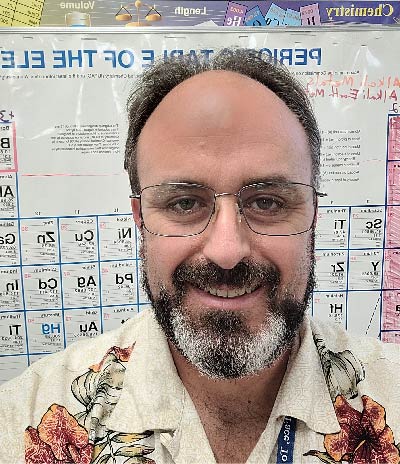 Chemistry teacher Uriah Albrink witnessed this in his classroom last year when the COVID-19 pandemic hit, and related misinformation flooded our newsfeeds. Students were misled by false claims, hoaxes and conspiracy theories spread by people and organizations that were far from credible. He knew he had to do something about it.
Chemistry teacher Uriah Albrink witnessed this in his classroom last year when the COVID-19 pandemic hit, and related misinformation flooded our newsfeeds. Students were misled by false claims, hoaxes and conspiracy theories spread by people and organizations that were far from credible. He knew he had to do something about it.
“With the amount of misinformation being thrown around, I felt it was my responsibility to make them better consumers of information,” said Albrink, who teaches at Mason County High School in Maysville, Kentucky. “We are getting this mindset of polarization [that] science isn’t real. That was a big red flag.”
Engaging students during remote learning
Like schools all over the country, Mason County High closed when the pandemic hit. Albrink needed to find resources that would engage his students and allow them to work independently in a virtual learning environment. He found what he needed in Checkology®, the News Literacy Project’s e-learning platform, and The Sift®, its weekly newsletter for educators.
“This seemed right up my alley, a way to teach good research skills and methodology,” said. Albrink, an educator with 17 years of experience who teaches mainly juniors and sophomores. “I felt it was important.”
Albrink used items featured in The Sift’s Viral Rumor Rundown to teach his students how to avoid being fooled by popular memes and provocative posts. “We’d do reverse image searches, talk through how to spot fake accounts on social media, and to take it all with a grain of salt,” he said.
Using real-life examples to teach foundational concepts of science literacy captured his students’ attention — and surprised them. “They’re just kind of amazed at how much falsehood is out there floating around.”
Making connections with science literacy
Albrink used the Checkology lesson “InfoZones” to help his students get a better grasp of the types of content they were seeing. Students learned how to differentiate among types of information — news, opinion, advertising, entertainment, propaganda and raw information. They tested their skills with examples in Checkology’s interactive Check Center and then independently applied the concepts they learned to news articles, judging credibility and putting information in context.
Their exploration of mask-related myths provided Albrink with an opportunity to connect the news directly to chemistry lessons. He taught them about the size of molecules and how being able to smell odors while wearing a mask does not mean masks are ineffective. These teachable moments from current events resonated. “It’s affecting their lives directly. Otherwise, if they can’t make a connection, it’s hard to engage,” he noted.
Teaching science literacy made him realize that kids often don’t have the essential skills to discern good information from bad and were being taken advantage of by those who create and share falsehoods. “Hopefully, I opened their eyes to be leery of what people say. If I can provide a layer of insulation, I feel like I succeeded with them.”
Albrink wishes that he had encountered news literacy resources and applied them to his science classes sooner. Now that he has, he will continue to weave science literacy into his classroom lessons. “To progress as a professional, I think this is the direction I want to go,” he said.
NewsLit Nation, The Juice partner to support educators
The News Literacy Project is pleased to announce a new partnership with The Juice, a unique learning program created to help students develop media literacy, reading comprehension and critical thinking skills.
“When considering partners to align with, The Juice just made sense,” said Ebonee Rice, NLP’s senior vice president of the educator network. “They uphold a high bar for helping educators source content to teach the specialized pedagogical methods specific to the process of news literacy and critical thinking. We are excited to see how this platform enhances our network’s ability to positively impact news literacy education.”
Through this partnership, members of NLP’s national educator network, NewsLit Nation, can use the resources of this current events-focused learning platform free during this school year and at a reduced price thereafter. (Educators who have not yet joined NewsLit Nation can easily register now.)
Educators can apply Checkology® virtual classroom lessons or NLP’s other educator resources and use them with The Juice, which is designed specifically for educators and students in grades 5-12. The learning platform’s newsletter, The Daily Juice, is created by journalists, educators and assessment experts. The Daily Juice enables students to quickly read a few of the most interesting news stories of the day. These include narratives of positive human accomplishments, vocabulary builders and STEM concepts. An assessment question follows each story, and teachers receive real-time diagnostic data about student performance that highlights standards mastery and accountability.
Each story is published at four different competency levels, so students have access to the same information regardless of their reading level. This provides an opportunity for inclusive classroom conversations around the same topics.
Follow this special link to sign up for a no-obligation trial.
About The Juice
The company comprises experienced educators, journalists and technologists committed to making students better critical thinkers, communicators and citizens by equipping them with the tools to thrive in the 21st century. The Juice is a “plug-and-play solution” that aims to make educators’ lives easier and empower educators to make informed, data-driven learning decisions.
For student leader, news literacy brought growth and opportunity
At NLP, we know that our programs and resources work — our metrics tell us so. But statistics don’t show the personal impact of news literacy education, and we find those stories inspiring.
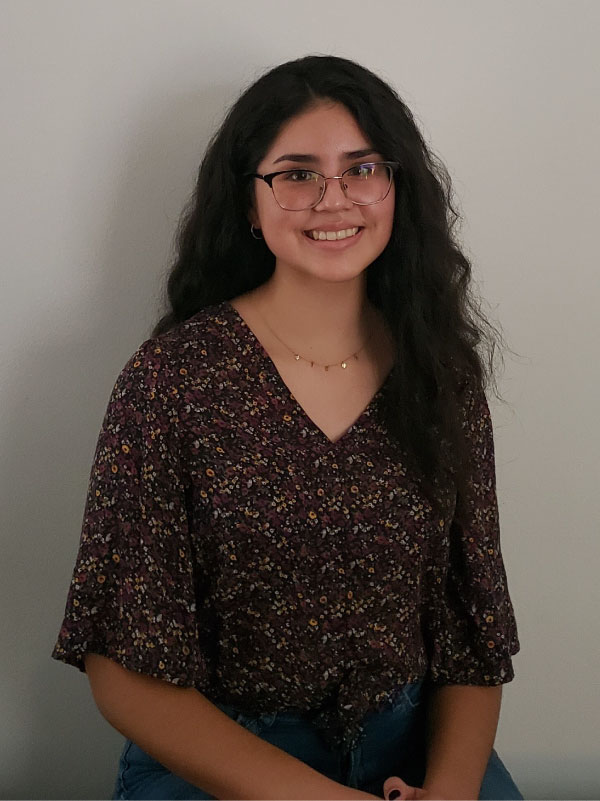 That’s why we recently checked in with Valeria Luquin. We met her in 2019 when she was a freshman at Daniel Pearl Magnet High School in Van Nuys, California. Journalism teacher Adriana Chavira introduced Luquin and her classmates to news literacy using NLP’s Checkology® virtual classroom when they were ninth graders. Valeria quickly grasped the concepts and applied what she learned to her daily life. She did so well we named her our Gwen Ifill Student of the Year! In this video she talks about helping family and friends become more news-literate and acting as a good role model for her younger sister.
That’s why we recently checked in with Valeria Luquin. We met her in 2019 when she was a freshman at Daniel Pearl Magnet High School in Van Nuys, California. Journalism teacher Adriana Chavira introduced Luquin and her classmates to news literacy using NLP’s Checkology® virtual classroom when they were ninth graders. Valeria quickly grasped the concepts and applied what she learned to her daily life. She did so well we named her our Gwen Ifill Student of the Year! In this video she talks about helping family and friends become more news-literate and acting as a good role model for her younger sister.
Today, Luquin is a high school senior and news magazine editor-in-chief at her school’s student-run news website, The Pearl Post. She also represents the student body as its vice president. “I look back on who I was freshman year [and] I notice a huge growth in myself as a person and as a student journalist,” said Luquin, who is also co-host of the school’s new Room 22 podcast.
Changing with the times
Chavira, who still teaches journalism at the school, tackles the changing trends in how students get their information. “As students increasingly rely more on their news from social media platforms such as TikTok, I’ve put more of an emphasis on asking them where they get their information,” she said. “I’ve always encouraged them to double-check the information to ensure that they are re-posting accurate information, especially in the past year with news of the Jan. 6 insurrection and COVID-19 pandemic.”
The students are changing as readily as the information landscape, Chavira said. “I’ve noticed that my freshmen this year come in with more news literacy skills than in previous years. They already know to double-check the information on social media, especially if it’s only one account reporting certain information.”
That kind of savvy is simply a part of who Luquin now is. “I still find all of the information from Checkology to be useful in my everyday life,” she said. That includes identifying credible sources and having a deep appreciation for the work journalists do to inform the public. “I am still not sure what I would like to major in, but a career in the journalism field is one of my top choices.”
Whatever path she chooses, Luquin credits her involvement with NLP for giving her an advantage early on. “The News Literacy Project opened up a lot of doors for me, especially after I was awarded the Gwen Ifill Student of the Year award. I am grateful for all they have done for me and for the work they continue to do to teach young teenagers about the importance of journalism.”
Librarian K.C. Boyd an advocate for students, community, profession
When you think of a librarian, do you envision that old movie cliché of a timid woman putting a finger to her lips and “shushing” readers? If so, you’ve never met K.C. Boyd, a public-school librarian in Washington, D.C.
Last year, Boyd became one of NLP’s first News Literacy Ambassadors, educators who work in their communities to help bring news literacy education to their schools and create a generation of civically engaged news-literate adults. Boyd is a passionate advocate for her profession, her students and her community.
For example, earlier this month she and her fellow librarians worked to support an amendment to the District of Columbia’s public schools budget to provide $3.25 million for the restoration of full-time librarian positions in 36 schools, many in under-served neighborhoods. That amendment, introduced by District of Columbia Councilmember Janeese Lewis George, was unanimously approved by the District Council in early August. Boyd said the victory was the result of hard work by a coalition of educators, school district leaders and parents. “We’d been fighting for 18 months,” she said. “It was a big lift, and I’m thankful for the unanimity. Now we’re making an extra push to make the positions essential.”
Second generation educator
Boyd’s deep commitment to education runs in the family. Raised in Chicago, both of her parents were science teachers, and her mother later became a computer science teacher. But Boyd, who has been a librarian for 24 years, says she at first resisted her parents’ encouragement to become an educator. After college, she worked in corporate America as a recruiter for a Fortune 500 company. When she began to feel stalled in her position, her father again made his case. “He swooped back in and got me to go back to school for a master’s in library science,” said Boyd, who has been a librarian at the district’s Jefferson Middle School Academy for five years.
Previously, she served as the Area Library Coordinator for Chicago Public Schools and was a District Coordinator for the Mayor Daley Book Club for Middle School Students. She also was the lead librarian in East St. Louis, Illinois. She also holds master’s degrees in media communications and education leadership.
‘You’ve got to give them a platform to discover’
Boyd currently serves on the executive board for the District of Columbia Library Association and the Advisory Board for EveryLibrary. She is a member of the American Library Association Chapter Council representing Washington D.C., the American Association of School Librarians Digital Tools and the Washington Teachers’ Union Equity Collaborative.
Over the course of her career, she has seen how technology has changed libraries and the way people use them but says the essence of her role is largely the same. She continues to help students discover the joys of reading every day, improve their research skills, receive the preparation needed to succeed in high school and grow into upstanding digital citizens. That concept, practicing responsible digital citizenship, is embedded in the media studies course that she teaches.
“I incorporate many different programs in this course. I use current events from The Sift® [NLP’s free weekly newsletter for educators] and apply that to a lesson or activity,” she said. “It challenges their thinking and their place in the world. And they learn a lot. You’ve got to give them that platform to discover.”
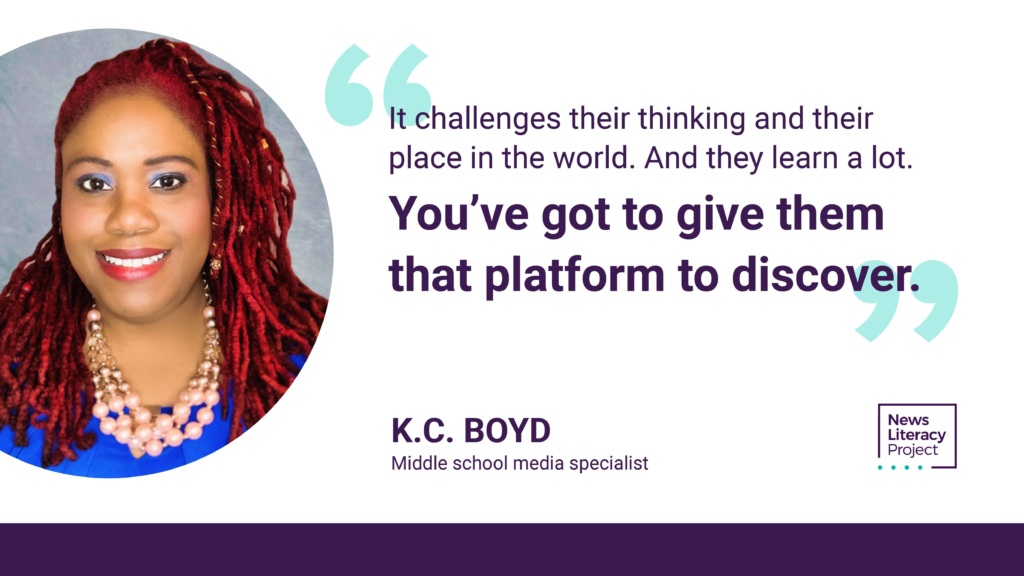
Having seen students struggling to discern credible sources and information from a flood of misinformation, Boyd wants to make an impact outside her classroom as an NLP ambassador. After a school year disrupted by the pandemic, she is looking forward to developing a plan to involve educators in D.C., Maryland and Virginia in efforts to promote news literary education and hopes to get organizations that serve educators and librarians on board. When you visit Boyd’s website The Boss Librarian Blog, the passion that makes her an ideal ambassador is evident in the tagline at the top of the page: “Bringing the zeal back to school librarianship.”
Back to school with the News Literacy Project
With the start of the school year, are you ready to dive into news literacy education? Becoming news-literate helps students learn to better navigate our complex information landscape and avoid spiraling down misinformation rabbit holes. It’s also essential to being civically engaged.
The events of the last 18 months have made it clear just how urgently students need news literacy skills. If you want to help your students discern facts from falsehoods, start with the News Literacy Project (NLP). We’re the leading provider of impactful, relevant and FREE resources and programs for teaching news literacy.
Begin by registering for NLP’s e-learning platform, the Checkology® virtual classroom, where your students will learn to identify credible information, seek out reliable sources, recognize misinformation and help stop its spread. The lessons also help them understand the role of the free press and the First Amendment in our democracy, and they are aligned to the C3 Framework, Common Core State Standards-ELA and to the ISTE standards. Checkology lessons also enhance students’ comprehension across disciplines. And be sure to join NLP’s NewsLit Nation, a national network to engage and mobilize more than 40,000 educators in all 50 states.
Events for the new school year
NLP supports your work throughout the school year, beginning with a variety of events and offerings. Choose the one that works best for you.
- Register for the webinar Getting Started with Checkology. Select from one of three dates: Aug. 19, Aug. 30 or Sept. 15.
- Take part in our Twitter chat on blended learning Aug. 26, from 4 to 5 p.m. ET at #NLPchat.
- Don’t miss our free virtual NewsLitCamp®, a unique professional learning event presented with our news partner, The 19th*, on Aug. 27.
- Teach your students about the dangers of conspiracy theories with the Sept. 2 EdWeb webinar Avoiding the rabbit hole: Teaching concepts in conspiratorial thinking.
- Go deeper with our fall news literacy webinar series, which covers foundational concepts and curriculum integration. The series begins Friday, Sept. 3, at 4 p.m. CT
- Challenge your students to compete in an “InfoZones” lesson contest. Ask your students for examples of information about topics that interest them and we’ll feature the winning content in a new “InfoZones” exercise. The contest closes Oct. 15.
Online resources always available
- Explore the FREE classroom-ready material on our website, including the new infographics, How to teach news literacy in polarizing times and Eight tips to Google like a pro.
- Check out our “News Literacy Foundations” collection on Flipgrid.
- Watch these videos to see how other educators found creative ways to teach news literacy during the challenging 2020-21 school and benefit from their lessons learned.
Throughout the pandemic, when thousands of schools had to rely on distance learning, demand for Checkology surged. Aaron Feldstein, a middle school social studies teacher in California, is one of many educators who told NLP how much they valued our work. “If I were in charge, Checkology would be part of a national mandated curriculum for sure,” Feldstein said.
Whatever this school year brings, you can be sure NLP will be there to continue supporting educators and students avoid misinformation and become more news-literate.
NLP and Checkology® honored by Library Association
We’re proud to announce that NLP and our Checkology® virtual classroom have been selected in the annual list of the Best Digital Tools for Teaching & Learning by the American Association of School Librarians (AASL). The organization recognizes electronic resources “that provide enhanced learning and curriculum development for school librarians and their educator collaborators.”
NLP was honored, in part, for providing high-quality resources that educators were able to adapt for use during the COVID-19 pandemic. Checkology was recognized as one of the best electronic resources available.
“The digital tools honored in 2021 demonstrate how education has stepped up to support remote and blended learning environments,” AASL said. “They provide high-quality resources for many content areas and engaging learning activities. In developing the list, the committee also focused on equity and access.”
The organization released the list this week and you can access the full list of honorees at www.ala.org/aasl/best.
“NLP is thrilled that Checkology is being recognized for the free resources it offers to help educators teach news literacy and to connect all students with news literacy education,” said Ebonee Rice, NLP’s vice president of the educator network. “Today’s students are navigating an incredibly complex information landscape and Checkology is more important than ever.”
Checkology helps middle and high school students learn how to identify credible information, seek out reliable sources, and apply critical thinking skills to separate fact-based content from falsehoods. NLP expanded access to Checkology last year by dropping the paywall for educators and parents engaged in distance learning or homeschooling, due to the pandemic and school closures.
Teachers share how they used Checkology in challenging year
The 2020-21 school year has been anything but routine for teachers and students all over the world. Unpredictability led to a mixture of remote, hybrid and in-person learning environments — with some classrooms experiencing all three. At the same time, demand grew for resources to teach students how to separate fact from fiction and identify and combat dangerous misinformation. The Checkology® virtual classroom was an ideal resource to meet that demand across learning environments.
The News Literacy Project (NLP) set out to better understand educators’ experiences teaching news literacy. We asked several teachers to record short videos answering the question, “How did you use Checkology this past year?” Check out their responses below.
K.C. Boyd, library media specialist
Jefferson Middle School Academy, Washington, D.C.
Boyd used The Sift®, NLP’s free weekly newsletter for educators, to “jump start” her news literacy lessons. When the jury delivered its verdict convicting former Minneapolis police officer Derek Chauvin in the death of George Floyd, Boyd discussed the five core values of journalism with students in her “Media Studies” class. “I knew that day that my students were going to be inundated with a tremendous amount of information and, unfortunately, misinformation. So, I was looking for a lot of material that would help remind them to seek out credible sources,” she says. “This platform has been a tremendous support and help in my instructional program.”
Her lesson, inspired by The Sift, focused on preparing students to actively seek out credible information concerning the trial and verdict.
Referenced lessons and resources to check out:
These two issues of The Sift are most relevant to Boyd’s lesson planning regarding the Chauvin trial:
- The Sift: Media trust insights | Covering Minneapolis | Spotting fake science – This issue discusses the five core values of journalism: “acting as watchdogs over powerful people; making information open and transparent; valuing facts in pursuit of truth; offering a voice to those lacking power; and shining light on societal problems.”
- The Sift: ’60 Minutes’ controversy | Trial coverage choices | Biden press questions – This issue includes classroom-ready slides about how local, national and international news organizations handled Chauvin trial testimony.
Maia Hawthorne, AP English and speech instructor
Twin Lakes High School, Monticello, Indiana
Hawthorne presented a four-day intensive news literacy mini-unit that featured lessons from Checkology, followed by news literacy “moments” throughout the year. She began by having students take the “How news-literate are you?” quiz. The results were “eye-opening” for her students, she says. They “are shocked to find out how little they actually know about how news works.” Afterward, “[students] consistently tell me that they love Checkology because it’s a chance to practice what they’ve been hearing, it’s hands on, it resembles things that they see when they go online and also it gives them a break from listening to me so much.” She taught mostly in-person during the 2020-21 school year.
Referenced lessons and resources to check out:
- Checkology virtual classroom – Checkology, NLP’s free e-learning platform, helps give students the habits of mind and tools to evaluate and interpret information.
- News Lit Quiz: “How news-literate are you?”
- Pear Deck – Hawthorne used Pear Deck to get feedback from students while presenting information about news literacy.
- The Sift – NLP’s free weekly newsletter for educators — delivered during the school year — explores timely examples of misinformation, addresses media and press freedom topics and discusses social media trends and issues.
- Check Center Missions – Hawthorne’s students “especially love[d] the Check Center missions where they feel like detectives.” Missions are fact-checking activities in which students get to the bottom of a piece of information using digital verification tools and skills they learn about in the Check Center.
Patricia Russac, library director and history teacher
Buckley Country Day School, Roslyn, New York
Russac taught in a hybrid learning environment this year and says the act of “teaching out and teaching in” was not easy. She used Checkology with sixth- and seventh-graders to build their news literacy skills and noted that Checkology worked well “because the resources are so accessible to remote learners as well as to students in the room.” After each lesson segment, Russac gave students the opportunity to ask questions and participate in class discussions. “The students had plenty to share about what they heard, saw and viewed online,” she says. “It was a powerful reminder as to why news literacy education should be part of every grade level and across subjects. It is not enough to teach it just in the humanities. Math and science need news literacy education as well. Data matters.”
Referenced lessons and resources to check out:
Russac’s students completed four Checkology lessons to develop their news literacy skills. Of the four, the students’ favorite lesson was “Conspiratorial Thinking.” Use the demo links below to preview the lessons. To learn how to assign lessons to students, check out our “Quick guide to assigning a course.” Here are the Checkology lessons Russac taught:
- “InfoZones”– Categorize information into one of six “zones:” news, opinion, entertainment, advertising, propaganda or raw information.
- “Misinformation” – Learn to understand different types of misinformation and the ways that it can damage democracy.
- “Understanding Bias” – Develop a nuanced understanding of news media bias by learning about five types of bias and five ways it can manifest itself, as well as methods for minimizing it.
- “Conspiratorial Thinking” – Discover why people are drawn to conspiracy theories and how our cognitive biases can trick us into believing they’re real.
Lauren Walton, library media specialist
North Reading Middle School, North Reading, Massachusetts
Walton created a brand-new digital literacy curriculum and used Checkology in a hybrid learning environment. “The interactive format of Checkology and my ability to see each individual student’s answers and progress kept students engaged and helped me assess students’ understanding and mastery of skills,” she says. Her middle school students particularly enjoyed the lesson “Arguments and Evidence,” because of their passion for debate. Using Checkology to support her digital literacy curriculum, Walton was able to help students “go from blindly accepting everything they read online to critically examining each piece of information to determine its author, purpose, and credibility.”
Referenced lessons and resources to check out:
You can find and assign Walton’s digital literacy course to your own class. Just select “Change course” in the course management area and assign “Digital literacy (by educator Lauren Walton)” under the preset course options that appear. Here are the core lessons featured in her course:
- “Introduction to Algorithms”
- “InfoZones”
- “Arguments & Evidence”
- “Understanding Bias”
Walton’s course also featured exercises, challenges and Check Center missions to help reinforce and extend student learning, which she found valuable. “I recommend that educators who are thinking about implementing Checkology into their classrooms use the Check Center…and show students the videos on fact-checking skills.”
Diana Montague, professor of communication and department chair
University of Findlay, Findlay, Ohio
Montague noticed that “students, like many adults, really struggle to distinguish news from opinions.” That’s why, in her “Principles of Speech” course, she asked students to choose a current event or issue and find a news article and an opinion piece relating to it. Her students then fact-checked and sourced both pieces of information. “Checkology was an excellent tool to introduce our speech students to some of the categories of mediated information and give them a vocabulary to identify and distinguish news from opinion, news from propaganda or advertisements, and curated, verified news from raw information,” Montague says. “Checkology also helped [students] look for red flags to identify misinformation and it gave students some insight into how conspiracy theories are started and disseminated in the media.”
Her university experienced a variety of learning environments (in-person, fully remote and hybrid), and she credited “the asynchronous platform of Checkology” as providing “a stable set of exercises no matter where students were at any given time.” She enhanced her students’ learning by connecting lessons to what was unfolding in the news. “If you are planning on using Checkology, I would encourage you to reinforce the lessons by pulling in the day’s news, opinions or trending topics on social media feeds. This encourages students to apply what they learned from the exercises to breaking news,” she says.
Referenced lessons and resources to check out:
Montague assigned three core Checkology lessons to develop students’ news and media literacy. Use the demo links below to preview the lessons. To learn how to assign lessons to students, check out our “Quick guide to assigning a course.”
- “InfoZones” – Categorize information into one of six “zones”: news, opinion, entertainment, advertising, propaganda or raw information.
- “Misinformation” – Learn to understand different types of misinformation and the ways that misinformation can damage democracy.
- “Conspiratorial Thinking” – Discover why people are drawn to conspiracy theories and how our cognitive biases can trick us into believing they’re real.
Liz Norell, political science professor
Chattanooga State Community College, Chattanooga, Tennessee
This spring, Norell taught fully remote classes, and offered students course credit to complete some or all Checkology assignments and write a short reflection on what they learned. She knew that Checkology content would align well with her course focus “on how to become a competent citizen, how to evaluate information and how to have civil conversations across political differences.” It became clear to Norell after reading student reflections that “they thought they would be really good at determining what information was trustworthy or not and they really learned a lot.” Based on her experience, she encourages other educators to use the platform. “I hope that others will jump on board because I think [Checkology is] exactly what our students need at this moment in our history and in this political sphere,” she says.
Referenced lessons and resources to check out:
To replicate Norell’s student-choice-driven use of Checkology, simply assign the “All lessons” preset course to your class and then turn off the “Course Lock” setting. This will allow your students to see all available Checkology lessons and begin them in any order.
Patternicity contest demonstrates mastery of key concept
Our brains are built to look for patterns, and we tend to see them everywhere. We look up at a cloud and see the shape of a cat. Or we recognize the outline of a face in a puddle.
Patternicity is the term for this tendency to perceive meaningful patterns and connections among unrelated events. It’s often a harmless diversion. However, it can be used to support a belief that is otherwise lacking in evidence, like a conspiracy theory.
NLP created a contest to measure Checkology® students’ understanding of patternicity — an important news literacy concept. Students submitted a poster or infographic explaining the dangers of creating or believing false evidence rooted in patternicity.
Grace Bradley of Missouri won NLP’s first patternicity contest. The senior is a student in Nicole Cusick’s English class at Lee’s Summit West High School. Cusick taught patternicity in her media studies course as part of a segment on conspiratorial thinking. The course asks students to seriously evaluate media consumption and media’s role in society.
“When I saw the contest, I originally thought it would be a fun way to learn about conspiracy theories. After a closer look, I thought it would be a perfect way to have an authentic assessment of their learning about how conspiratorial thinking develops and the impact it can have on us and our society,” Cusick says.
Clear definition of patternicity
Kim Bowman, NLP’s user success associate, says Grace’s entry offered a clear definition of what patternicity is and why we tend to look for patterns. “Grace skillfully explained the dangers of this illusory perception (when it leads to conspiratorial thinking) using topical examples. In addition to being very informative, the final product was creative and unique with both the layout and images.”
“It was such a fun assignment and project, and I’m so proud of my infographic, so I’m really happy I won,” Grace says.
She also enjoyed using Checkology to study news literacy. For example, she likes the ease of use, ability to learn at her own pace and relevancy of the lessons. “I like how much effort they have put in to making it more interesting and interactive as well. They’re really moving with the times. Everything is tailored to high school students, and it really shows,” says Grace.
And the contest itself motivated students, Cusick says. The recognition helped them see the payoff from their hard work. It also gave students a new perspective about what they learn and why. “They are seeing how the skills of my English classroom are applicable to their lives outside of the classroom as well,” she says.
Click image thumbnails above to view the full posters created by Gabby Reynolds, Noah Stice and Miyabi Schroth (left to right).
The patternicity contest runners-up included two of Grace’s classmates: Gabby Reynolds and Noah Stice. Miyabi Schroth of Berkeley, California, is the other runner-up. Schroth is a student in teacher-librarian Melanie Ford’s class at Longfellow Arts and Technology Middle School, where the eighth-grader is also a library assistant.
Grace and Cusick will receive an assortment of NLP-branded swag in recognition of their work.
Journalist’s classroom visit high point of the year for California sixth-graders
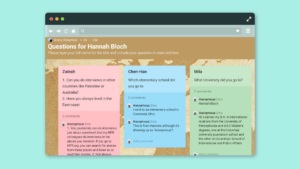
NPR journalist Hannah Bloch is used to asking questions, but during a virtual visit with 80 sixth-graders at Chaparral Middle School in Diamond Bar, California, she was the one peppered with them.
The conversation with Bloch, lead digital editor on NPR’s international desk, was the highlight of a media literacy component that educator Sherry Robertson developed for her language arts class.
“Speaking with Sherry Robertson’s class was a delight. The students were so engaged (even over Zoom, which I expected might be tough). Their questions were thoughtful, and I loved their genuine curiosity about journalism and what it’s like being a journalist,” Bloch says.
Robertson arranged the January visit through the News Literacy Project’s Newsroom to Classroom program. Part of the Checkology® e-learning platform, the program enables educators to invite vetted journalist volunteers to visit their classrooms in person or remotely.
“I felt very passionate about creating a unit on this. The younger we start, the better,” Robertson says. “I’m on a mission to do my part in the world to make my kids literate online.”
Before the visit, Robertson’s students completed the Checkology lessons “InfoZones” and “Arguments & Evidence.” They then submitted questions to Bloch ahead of time through the platform, Padlet.
Inspiring visit
Introducing a new subject area has both challenged and inspired Robertson. “As educators, we weren’t trained to teach this,” she says. “This is new for me. I’m teaching them something I’m learning at the same time.”
Bringing in a subject matter expert was a real help. The conversation with Bloch covered several topics, from what inspired her to become a journalist, to how she determines whether a story is credible, to which fast food restaurant she recommends.
“It was so amazing. She was fantastic and went out of her way to answer my kids’ questions,” Robertson says. And the conversation with a working journalist was eye-opening for her students. “She’s so accomplished, and here she is talking to them as equals. This was something my kids could aspire to. Journalism could be attainable to them. I don’t think they realized it,” she adds.
In a year when distance learning has posed significant challenges to educators, parents and kids, Robertson was able to easily arrange the visit with Bloch, who lives on the East Coast. And it was a natural fit given that everyone has essentially been “living” online since the pandemic began.
Robertson also wanted to ensure her students enjoyed their first year in middle school, despite the circumstances. She sought to keep them engaged and provide something fun. Bloch’s visit was just that. “This was literally the best experience my kids had this year,” Robertson says.
For Bloch, the visit was also a delight. “It was a pleasure to have the opportunity to spend that time with them and I’m thrilled to hear that they enjoyed it, too. And I have so much respect for the work teachers like Ms. Robertson are doing at this most challenging of times,” she says.
More Civil Union: The Role of News Literacy in Civic Education
Hosted by: Constitutional Democracy Project – IIT Chicago-Kent College of Law Presenter: Allie Niese, CPS Teacher
March 11, 2021, 4-5:30 p.m. CT
Sign up now!
This webinar will answer questions surrounding the role of news literacy in the classroom, share resources, and develop content knowledge to better support civil dialogue in the classroom. The session will address why it is important to be news-literate; will define misinformation, and explore what news literacy means to you, your classroom and your students.
What is the role of news literacy in our Constitutional democracy?
Presentation by Dr. Jon Marshall, Medill School of Journalism, Northwestern University
Teaching News Literacy: the New Literacy Project as a Toolbox
- Mission of the New Literacy Project
- How can I bring News Literacy into my classroom?
- Practice Checkology Lesson used, “Arguments and Evidence”
How can we engage students in the skills of news literacy in our Civics & AP Government classrooms?
How do you consume the news? Are you a morning podcaster, radio listener, printed newspaper reader, TV news watcher, or social media scanner?
Discussion Questions
- Which NLP resources do you find most immediately useful for your classroom? Why?
- What resources might you like to try out in the future?
- How and where do you see New Literacy fitting into the material you already teach?
- Review your challenges in news literacy, for yourself or your students? What resources at NLP might help you navigate these challenges?
To learn more contact Alyss Niese at [email protected]. Explore more phenomenal resources to teach about our Constitutional Democracy at Constitutional at democracyproject.org and more news literacy resources at newslit.org.
News literacy ambassador brings ‘seasoned’ approach to education
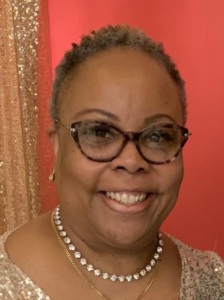 When you view educator Sandra Street’s LinkedIn profile, your gaze quickly finds the word “seasoned,” which appears directly under her name at the top of the page. In this understated way, she makes her wealth of experience and expertise evident.
When you view educator Sandra Street’s LinkedIn profile, your gaze quickly finds the word “seasoned,” which appears directly under her name at the top of the page. In this understated way, she makes her wealth of experience and expertise evident.
An award-winning history teacher at the Gordon Parks School for Inquisitive Minds in Queens, New York, and a news literacy ambassador for NLP, Street is committed to elevating her students’ learning experience through her “seasoned” approach.
“I remember many years ago, I bought a wok and was washing it out. My brother said, ‘Don’t wash it with soap and water, just wipe it out so that every time you cook, it seasons the food,’” she recalls. “When you add a little heat to something, you bring a whole lot of different flavors.”
This cooking metaphor, she believes, applies to teaching.
Street, who became an educator after working on Wall Street, harvests the flavors from a diversity of experiences and opportunities that she brings to the classroom. Here are just a few examples. She is a member of the New York State Council for the Social Studies Supervisory Committee and completed New York City’s Leaders in Education Apprentice Program. She studied the African diaspora at New York University and attended the Tufts in London program. Also, she earned a certificate in education leadership and administration from Harvard University’s Graduate School of Education.
News literacy ambassador, teacher
This ever-curious and engaged approach to learning and life led her to make news literacy education an imperative. “I have been teaching it because I’m compelled to do so. Because we’re living it,” says Street. This year, because of COVID-19 restrictions, she teaches history remotely to 74 eighth-graders.
NLP’s Checkology® virtual classroom is a main ingredient in this instruction. “When I went into Checkology, I just wanted to stay in there all day,” Street says. She considers the guidance to stop and weigh information before believing, sharing or taking action a fundamental lesson. “I use that in the classroom. I’ll say, ‘Let’s pause. Before you make a decision, make sure you are well informed.’”
Relying on events both current and historical, she encourages students to make their own realizations about the information they encounter. She reminds them, “I’m not here to tell you what to think; it’s my goal to get you to think.”
A mom herself, Street brings a maternal concern to the classroom. “What I want for my children, I want for other children: Access and exposure to information where they can find their truth,” she says.
As an NLP ambassador, Street advocates for news literacy education and support educators who join NLP’s News Literacy Educator Network — NewsLit Nation. This role gives her a new and important way to bring a little extra seasoning to the education system, and to her life.
NLP launches NewsLit Nation, the News Literacy Educator Network
Nationwide community of teachers, librarians and administrators advocate news literacy education
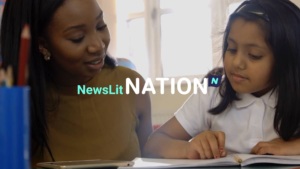 To work toward reducing the harmful effects of misinformation on young minds, NLP is launching NewsLit Nation, the home of its News Literacy Educator Network. NewsLit Nation members advocate for news literacy education and support educators helping students navigate the complex digital news ecosystem.
To work toward reducing the harmful effects of misinformation on young minds, NLP is launching NewsLit Nation, the home of its News Literacy Educator Network. NewsLit Nation members advocate for news literacy education and support educators helping students navigate the complex digital news ecosystem.
With educators on the frontline of the fight against misinformation, NewsLit Nation provides resources and know-how for this urgent and important work. The network also organizes locally to enable educators to push for news literacy instruction in their schools and communities, says Ebonee Rice, NLP’s vice president of the educator network.
“We’re building an army of news literacy educators to mobilize their peers and create a future founded on facts,” she says. “We’re here to empower educators with the tools they need to actively teach students the abilities to become equal and engaged participants in our democracy.’’
What is NewsLit Nation?
NewsLit Nation:
- Trains teachers, librarians and school administrators across the country to advocate on behalf of a news literacy curriculum.
- Helps you find opportunities for local partnerships and build channels of communication for your communities as local news literacy champions.
- Gives you access to exclusive professional development opportunities, webinars, other training and additional support through online forums and message boards.
- Acts as the resource library for all our news literacy materials for educators.
And, NewsLit Nation includes a network of ambassadors — educators working to create a sense of community in their local and regional school districts. (Thirteen news literacy ambassadors are already working in 10 cities across the country.)
Educators can easily join the network by registering here.
School Library Journal spreads word about educator network
The School Library Journal spoke with Ebonee Rice on Feb. 3 about NLP’s new educator network. “We really understand that educators are the experts and educators are really on the front lines in the fight against misinformation, so we wanted to create a community where educators who are doing this work can talk to each other,” Rice says in the article News Literacy Project Launches NewsLit Nation, a National Educator Network. “The end goal is to incorporate news literacy into the American education experience, allowing people to use best practices to figure out the best way to incorporate news literacy into their specific context.”
Delivering news literacy to journalism students, remotely
When the Houston Independent School District started the 2020-21 school year with 100% remote learning, journalism educator David Fanucchi needed to find an engaging way to teach news literacy to his students at Margaret Long Wisdom High School.
A colleague at Houston’s Bellaire High School, Andrea Negri, suggested NLP’s Checkology® virtual classroom. The browser based, e-learning platform with interactive lessons that students can do independently was exactly what Fanucchi was looking for.
“I thought Checkology provided a fantastic way for students to complete some relevant online lessons about journalism at a time when it is so difficult to keep their attention remotely,” Fanucchi says. “Teachers are struggling to find tools like that to use, and I was just so excited that these easy-to-understand modules were created and that I could use them in my classes.”
He assigned all seven of his classes the Checkology 101 course, which explores essential news literacy topics through the lessons “InfoZones,” “The First Amendment,” “Democracy’s Watchdog,” “Practicing Quality Journalism,” “Understanding Bias” and “Misinformation.” The course also includes related activities, such as source detection and evidence evaluation “missions” to reinforce the lessons.
“We went through them all in about three weeks (a total of six or seven class periods that each lasts about 90 minutes),” Fanucchi explains. “This was all done virtually on their own laptops.”
A deepened understanding
Dulce Macha, a sophomore in one of Fanucchi’s journalism classes, had a basic understanding of news literacy before she began using Checkology. “What I had known about news literacy was that it helps you judge the reliability and credibility of information given,” she says.
But the lessons deepened her knowledge. “The most surprising thing that I learned during the course was that there are many steps that go into a journalist’s work, such as checking for credibility and staying away from bias,” Macha says.
Fanucchi found the “Practicing Quality Journalism” lesson particularly valuable to his student journalists. “It taught them a real-life scenario of being a news reporter and covering the scene of a car crash. I think it did a phenomenal job of giving the students a real feeling of what a journalist does to ensure accuracy in his/her reporting,” he says.
Macha enjoyed that assignment and how Checkology enabled her to illustrate what she learned in different ways. “What I liked about the lessons was that they had areas where we had to choose the right answer and also areas where we had to be in the journalist’s shoes, and write our opinions on it,” she says.
‘Extremely important during these times’
Fanucchi says students need help understanding how credible journalism works and identifying reliable sources and fact-based information. “It is extremely important during these times of so much chaos in the news business. Students are having a harder time every day figuring out what the truth is,” he says.
Since studying news literacy, Macha is having an easier time doing just that. “It has changed the way I consume the news and judge content and sources. This course has given me a way of judging the credibility of the news that I read and judging whether it could be fake or not,” she says.
Macha has not yet needed to help friends or family members avoid being fooled by misinformation, but she is prepared to do so. “If there was a point where something like that happened, I would certainly help them out and talk to them about the ways they should judge the credibility and reliability of the information given,” she says.
Making civics relevant through news literacy
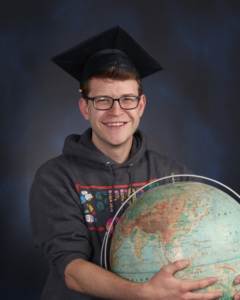
Scott Zwierzchowski teaches civics to students in grades 11 and 12 at Lincoln Park High School in Chicago. In September 2020, he and his colleagues implemented a short news literacy unit. Their goal is to prepare students to evaluate sources and sort fact from fiction throughout the year. NLP recently checked in with Scott to learn more about how he incorporates news literacy into his courses. Teaching is taking place in a fully remote learning environment due to the COVID-19 public health crisis.
NLP: Why did you decide to use Checkology®?
SZ: [My colleagues and I] had a conversation about the continual need to connect civics and government topics to modern day issues and debates/discussions, and thus a need for quality news literacy. After finding more out about Checkology, I was really psyched about it. Looking at how interactive Checkology was, and how it was really tailored to ease of use and quality engagement tools, we knew it would be helpful for us. In addition, the option to bring in a vetted, professional journalist into the classroom was a very intriguing option — although we ultimately did not do it for time constraints, I think we would pursue it in the future..
NLP: How did it fit in with your civics/law focus?
SZ: We try to start out the year with a unit on news literacy. Our plan has been to introduce topics of news literacy and continually refer back to them throughout each unit of study, but that is a continual process of development. My colleagues and I are working on ways, for example, for students to use the summative assignment they make throughout the year to evaluate sources they find online.
NLP: What did fully remote implementation of Checkology look like?
SZ: It looked different on different days! On some days, we would introduce the topic synchronously in our Google Meet, for about 10 to 15 minutes, then let the students loose to do the lesson on their own, and I would give feedback to the students as they completed it. On one day, we did it together by me projecting the lesson and them answering the questions on their own devices. That worked decently well, as they were already a bit familiar with that format through PearDeck.
NLP: What did students think about using the platform?
SZ: Students reported really liking the asynchronous aspect. They also reported really liking the format — they said it was easy to navigate, easy to answer questions, and was super simple to provide their ideas. They thought it was clear, and mentioned that they learned from it, and also mentioned that it wasn’t too hard, or too easy.
NLP: What kind of impact have the lessons had on your civics students?
SZ: I think our teachers on the team have seen some great improvements! As we dive into our elections unit, the students are demonstrating skills of being keenly aware of the author of the source, biases of sources, and have pointed out even logical fallacies of their peers, other teachers, and administrators.
NLP: Do you plan on using Checkology in the future?
SZ: We DEFINITELY plan on using it in the future. I’ve been recommending it to colleagues who teach the AP Government and Politics course, and others throughout our school, and how beneficial it is. Ultimately, I’d love to create more plans to bring a full, longer unit into fruition.
Check out this civics news literacy unit
Checkology teachers: assign Scott’s course to your class. Click here for instructions.
Essential question
What does it look like to be an educated information consumer?
Objectives
Students will be able to achieve mastery in the following unit content topics and skills.
Topics
- Defining news
- Media bias
- Language in news
- Commentary vs. news
Skills
- Identify news source information
- Analyze news sources for purpose and content
- Evaluate news sources for bias and logical fallacies
Unit plan
Day 1: What is News?
What factors determine the newsworthiness of a story? Students learned about Checkology’s “Big Four” factors in the lesson “What is News.” They are the extent to which something is timely, interesting, important and unique.
Day 2: Understanding Bias
Students completed the Checkology lesson. Then, they examined three news stories in groups and analyzed the types and forms of bias that they may have detected in the stories.
Days 3 and 4: The Power of Language with Checkology’s “Arguments and Evidence” lesson
On day 3, students completed “Arguments and Evidence” asynchronously. Then, together in class on day 4, students debriefed on the lesson and further practiced together remotely using the “Spot the Logical Fallacy” exercise from Checkology.
Day 5: Fact-checking in the digital age
Students supplemented Scott’s fact-checking lesson with the Checkology fact-checking mission “Verifying social media content” with David Clinch from Storyful.
- Note: The class went through Hurricane Sandy photos [in this slide deck] and discussed “How might people who are trying to get information about the hurricane have been influenced by the images?” Discussing how altered images and unconfirmed sources affect one’s perception of the world helped us ground some of our initial ideas on verifying online content. Discussing the Truman photo and its impact helped us further discuss why verifying information in all forms of news media is important (which we’ll definitely be talking about in class this week post-election). We had used this fact-checking in the digital age handout, but found that many students have used this site before in their computer science classes. Therefore we went with the Checkology lesson. Students said the lesson made the task easy to accomplish and helped them better understand the steps for fact-checking. The Checkology lesson also provided them with a more realistic example of what they would see every day, versus examples concocted for classroom purposes.
Days 6 and 7: End-of-unit project
Students created a process to help them determine the credibility of a news source. This process is meant to be used throughout the year when studying other topics and referencing news sources. View the assignment and a template You can also use Checkology’s Quick Check widget in the Check Center to help guide students through the process of determining the credibility of a claim or a source.
NLP offers new, urgently needed lesson on conspiratorial thinking
As recent events have demonstrated, false conspiracy theories online can fuel dangerous actions in real life. In this context, NLP is introducing a new lesson to educate students and the public about how conspiratorial thinking develops and its effects.
The comprehensive “Conspiratorial Thinking” lesson, included with NLP’s free Checkology® e-learning platform, seeks to help people understand the factors that allow conspiratorial thinking to take hold and conspiracy theories to flourish. It is available to educators and the general public.
You can preview the lesson here. For the best experience, register here to explore this and all Checkology lessons.
“The need to educate about conspiracy theories and why people believe them cannot be understated,” said John Silva, NLP’s senior director of education and training. “This is why we developed a lesson to teach young people about conspiratorial thinking and how it leads to a breakdown of critical, rational thought and belief becoming more important than facts. We must address the warning signs of cognitive dissonance and motivated reasoning — the thought processes that make us seek any information to support a belief.”
Renée DiResta, research manager at the Stanford Internet Observatory who investigates the spread of false narratives across social networks and assists policymakers in understanding and responding to them, hosts the lesson.
The new lesson teaches people to understand key components of conspiratorial thinking, including:
- What a conspiracy theory is and what separates it from other kinds of misinformation.
- How it can be captivating despite a lack of evidence to support it.
- The real-world consequences and the political and social impact of conspiracy theories.
“More importantly, added Silva, “people will learn how to recognize forms of cognitive biases that make false information seem true and how to evaluate sources and accept information as true only if it is verifiable and credible.”
“Conspiratorial Thinking” is the 14th lesson in NLP’s browser-based platform, which teaches students how to navigate the digital landscape by developing news literacy knowledge, skills and habits of mind.
EdSurge calls NLP website “treasure trove of resources”
“Young people have a right to news literacy education,” NLP’s John Silva says in the piece Can Your Students Tell the Difference Between Fact and Fiction? for EdSurge on Oct. 20.
Reporter Kimberly Rues directs readers to NLP’s educator-focused digital material, saying “their website is a virtual treasure trove of resources.” She also recommends NLP’s Educator Resources Library. “These materials provide ready-made content that supports the professional development offered in the webinar, but that could also be used independently of NLP’s professional development offerings,” she notes. “One final News Literacy Project resource to mention is Checkology, an interactive platform that provides students with standards-aligned lessons, presented by information experts, including real world examples, Rues says.”
Checkology Office Hours are now open

Sign up to attend on Zoom at this link.
Join us on the last Thursday of each month at 1:30 p.m. PT/ 4:30 p.m. ET to learn more about the News Literacy Project’s Checkology virtual classroom.
Hear about recent platform updates, new resources, and commonly asked user questions. Each webinar will contain a live Q&A at the end to answer your questions!
NLP’s e-learning platform is now free
NLP is now offering its signature e-learning platform Checkology® free to help ease the transition to remote teaching and hybrid learning environments for educators and families. By removing barriers to access, NLP will support educators across the country with essential news literacy lessons at a time of urgent need. Misinformation about COVID-19, the upcoming presidential election and nationwide demonstrations against racial injustice has sown confusion, divided voters and put people’s lives at risk.
Checkology teaches young people to recognize and debunk misinformation, understand the vital role of a free press in a democracy, and become informed and engaged participants in civic life. Leading journalists, along with First Amendment and digital media experts, guide students through the platform’s 13 interactive multimedia lessons. (One foundational lesson is translated into Spanish.) Featuring real-world examples from social media and news sites, these learning experiences resonate with students, test their understanding and teach them critical-thinking skills. Checkology has been updated for the 2020-21 school year, making it even easier to use, with one-click integration, drag-and-drop lesson customization and in-platform support.
NLP now on Flipgrid
In addition to free Checkology, NLP is partnering with Microsoft’s platform Flipgrid to help educators connect with more students through social learning. Teachers create “grids” around available topics, or develop their own topic material for the platform, with question prompts that students answer by video. NLP’s content includes various news literacy topics, many building on Checkology lessons, as well as activities for students, including fact-checking “missions” and misinformation “quests.”
To further support educators, and to build a community around news literacy education, NLP is also creating a national news literacy educator network. As part of this new educator network, NLP is training teachers, librarians and school administrators across the country to support a news literacy curriculum, help find opportunities for local partnerships and build channels of communication for their communities as local news literacy champions.
Educators interested in becoming ambassadors can access NLP’s online application at www.newslit.org, starting on Aug. 17. The network will formally launch in January 2021. You can send questions to [email protected].
NLP working to counter the impacts of ‘Truth Decay’
A new report from the RAND Corporation, a nonpartisan nonprofit research organization, confirms what we at the News Literacy Project have long known: There’s an urgent need for media literacy education that is scalable, culturally relevant and readily available.
Released earlier this month, Exploring Media Literacy Education as a Tool for Mitigating Truth Decay was produced as part of a RAND initiative exploring “Truth Decay,” which it defines as “the diminishing role that facts, data and analysis play in political and civil discourse” — in part, because of an increasingly complex information ecosystem. This report aims “to describe the field of media literacy (ML) education and the ways in which ML education can counter Truth Decay by changing how participants consume, create, and share information.”
NLP’s expertise as a leader and pioneer in news literacy education is noted throughout the report, which weighs the input and suggestions of many experts in the field and lays out the challenges to developing meaningful education programs that can be scaled for significant impact.
Challenges and solutions
The RAND researchers describe the obstacles to buildi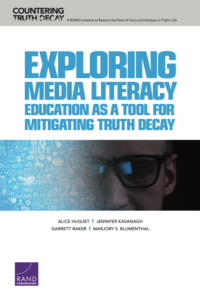 ng a news-literate population, such as the many skills needed to evaluate sources, to understand context, and to create and share information responsibly. They identify the alarming gap between proficiency in these skills and the abilities of average individuals: a gap that results in harmful consequences — vulnerability to disinformation, misinformation, viral hoaxes and bias.
ng a news-literate population, such as the many skills needed to evaluate sources, to understand context, and to create and share information responsibly. They identify the alarming gap between proficiency in these skills and the abilities of average individuals: a gap that results in harmful consequences — vulnerability to disinformation, misinformation, viral hoaxes and bias.
Our programs provide educators with the tools and resources that enable their students to close that gap and become civically engaged, news-literate adults. While the challenges detailed are real, I can say with confidence that NLP is successfully meeting many of them:
- The report describes the importance of scaling programs for significant impact. At NLP we have laid out a framework for scaling our e-learning platform, the Checkology® virtual classroom, with the goal of creating a community of 22,000 educators teaching 3 million students annually by 2022. Since its launch in 2016, more than 129,000 students have created individual accounts on our browser-based platform (this does not include the many students who have been taught in a one-to-many format), and more than 19,000 educators in all 50 states, four U.S. territories and 108 other countries have registered to use it.
- The report rightly states that for media literacy education to succeed, it must be rigorously nonideological. All of NLP’s programs, including Checkology, are scrupulously nonpartisan and represent a variety of perspectives.
- The report explores whether media literacy education should be a stand-alone offering or integrated across disciplines. Because media literacy is an essential life skill, we have designed our programs for cross-discipline learning and lasting impact. Our curriculum conforms to state standards across disciplines (such as English language arts and social studies) and is used by media, technology and science educators. The critical-thinking and analytical skills that students gain from news literacy education serve them well long after they leave the classroom.
- The report notes the need for more developed assessment and evaluation of media literacy programs. For years, we have used formal assessments of students’ competencies before and after they are exposed to our platform, along with self-reported student feedback, to evaluate and enhance our curriculum. The impact is evident in what we heard from students who completed Checkology lessons in the 2017-18 school year (the most recent data available): 93% are more confident in their ability to detect misinformation, 81% are more likely to become more civically engaged, and 80% are more likely to correct misinformation they see online.
- The report cites experts who emphasize that the most effective media literacy education strategies “are those that reach participants in a format and context with which they are familiar and comfortable.” We reach students where they live — on their devices. And the report indicates the need for context and flexibility. Checkology lessons can be taught in a sequential order, or educators can customize them to serve their students at different grade or skill levels and in a wide range of subject areas.
Working with diverse partners
The authors also stress partnering with media organizations to achieve scale. Right from the start, NLP has partnered with outlets such as The Wall Street Journal, NPR, The Washington Post, The Houston Chronicle and Univision.
We did this for years through our initial classroom program and have continued to do so through our NewsLitCamps®, which bring scores of educators into newsrooms for a day of engaging teacher-driven professional development. This fall, we will fully launch our Newsroom to Classroom program, which will bring journalist volunteers into schools around the country, either in person or remotely. Diverse and dynamic journalists and experts on the First Amendment and digital media guide students through our Checkology lessons as well.
I welcome the conversations, collaboration and increased awareness that RAND’s timely work will prompt and look forward to expanding NLP’s contribution to the growing field of news literacy education.
Checkology changes how student engages with the world
Diego Hernandez, who recently completed ninth grade at Daniel Pearl Magnet High School in Van Nuys, California, believes misinformation can harm your outlook on the world.
But Checkology® virtual classroom, which he used in his journalism class, has changed how Diego approaches news and other information. “Now I’m thinking on both sides of the spectrum,” he says. “It just gives you a whole new way of thinking about certain things.”
The platform also has taught him to take a step back and evaluate information more critically. He has become aware of bias in the information he consumes and seeks out information that is fact-based rather than opinion-based.
“I’ve changed a bit as a person. My opinions have altered a bit,” Diego says.
Learn more about how Checkology has impacted Diego in this video.
Education can solve ‘dueling facts’ phenomenon
The conclusions that political scientists Morgan Marietta and David C. Barker reach in their new book, One Nation, Two Realities: Dueling Facts in American Democracy, are enough to make the reader despair.
Based on data from national surveys conducted from 2013 to 2017, they determined that “dueling fact perceptions are rampant, and they are more entrenched than most people realize.”
In an article published May 8 on the NiemanLab website, the authors noted that, according to their findings, Americans no longer agree on basic questions of fact and often cling to beliefs that align with their values, regardless of evidence to the contrary. And fact-checking by reliable organizations appears to have little success in correcting people’s erroneous views. “This has serious implications for American democracy,” they warned.
I couldn’t agree more.
However, I think that Marietta and Barker are mistaken in their bleak prognosis: “Perhaps the most disappointing finding from our studies — at least from our point of view — is that there are no known fixes to this problem.”
The fix
There is no denying that today’s complex information ecosystem challenges all of us, but I believe that there is a fix to the problem: news literacy education. News literacy must be embedded in the American education experience. Nothing less than the health of our democracy is at stake.
As the founder of the pioneering News Literacy Project, I have seen how real-world news literacy lessons can empower middle school and high school students. The Checkology® virtual classroom, our e-learning platform, reaches them as they are forming the habits of mind and the patterns of content consumption and creation that will last a lifetime, and it does so where they live — online.
The value of these newfound and lasting news literacy skills has resonated with Judy Bryson, a library media teacher at Wilmer Amina Carter High School in Rialto, California. “If students are going to advocate for themselves and become empowered citizens, they need to know where to find quality, trustworthy information,” she said, adding that Checkology has helped her integrate library and research skills into a variety of subjects.
Meaningful engagement
The platform’s relatable examples engage students in meaningful ways. They begin by learning to identify types of information based on its primary purpose (to inform, to entertain, to persuade, to provoke, to sell or to document) and then review examples of content and assign them to the correct categories.
In another lesson, students take on the role of a reporter covering a breaking news story. They learn the importance of evaluating sources, weighing witness accounts, paying attention to attribution and recognizing how the standards of quality journalism come into play. Other lessons explore how to assess the authenticity of photos and videos and determine the credibility of memes and viral hoaxes.
In short, students learn to think like journalists: After all, in the digital age, anyone can be a publisher, and everyone must be an editor.
Critical thinkers
Checkology doesn’t just impart specific news literacy skills; it helps students become critical thinkers. They learn to approach information with equanimity, not emotion; to value credibility, not clickability. This deliberative mindset will serve them well through a lifetime of informed decision-making.
Educators see how transformative this can be in their classrooms — and beyond.
Nicole Finnesand, a middle school language arts teacher in Colton, South Dakota, said that Checkology has provided a framework for her deeply polarized class to have constructive and civil discussions about current events and political issues. Students now come to class armed not just with opinions, but with facts and legitimate sources. (As an example, they no longer cite The Onion’s satire as the basis for their arguments.)
David Teeghman, who spent several years teaching at a Chicago high school, said the platform helped him inoculate his digital journalism students against conspiracy theories and manipulated or fabricated content. He recalled seeing one of his former students post a falsehood on Facebook. Before Teeghman could respond, other former students jumped in to respectfully call it out.
Empowered students
Students immediately begin to apply these lessons in the real world.
Valeria Luquin, a ninth-grade student at Daniel Pearl Magnet High School in Lake Balboa, California, said that her father had recently told her about a documentary he had watched. “Are you sure that the sources and the documentary are credible?” she asked him. She said the ability to think critically about the media “is really helpful and important, because nowadays, with social media, there can be a lot of fake news.”
Sophia Fiallo, now a 10th-grader at The Young Women’s Leadership School of Queens in New York City, said her news literacy skills kicked in last year when a friend shared a photo of Emma Gonzalez, a student at Marjory Stoneman Douglas High School in Parkland, Florida, tearing up the U.S. Constitution. Fiallo discovered that it was a doctored photo of Gonzalez ripping a shooting target as a protest against gun violence. “It didn’t come from a reliable news source,” Fiallo said.
Ultimately, we want students to recognize that they can be part of the information solution, rather than part of the misinformation problem.
Daniela Rangel, one of Luquin’s classmates at Daniel Pearl Magnet High School, exemplifies this goal. “I like to help people in whatever way I can,” she said. “So if that means telling them that they should try to find correct information over what they are seeing on social media, then that’s good.”
Besides, she added, “I think my parents take me a little bit more seriously. Why? Because I’m more literate, and I sound professional now.”
Fox program and podcast spread the word about NLP in Los Angeles
Sunday’s episode of In Depth with Hal Eisner, a news program that airs on Fox11 in Los Angeles, led with a segment on misinformation featuring NLP founder and CEO Alan C. Miller and Valeria Luquin, a high school student who has learned valuable news literacy skills from NLP’s Checkology® virtual classroom. Eisner then invited Valeria’s mother, Lorena, to join them for a more detailed conversation about NLP and news literacy education on his podcast, What the Hal?
